HARVEST 2022 e v CATTLE CALLING • WEEDY WISDOM • SMOKIN’ THE HOG • CELEBRATE THE HARVEST SMOKIN’ THE HOG Pig roasts are a harvest tradition CATTLE CALLING Island bovines living the good life A CAPTAIN AND HIS CREW Steering the ship at l’étoile restaurant NO. 46 HARVEST 2022 OUR FOOD, OUR STORIES, OUR COMMUNITY MEMBER OF EDIBLE COMMUNITIES46
508.645.2628 Chilmark508.696.9999 West Tisbury


RED VALLEY ROAD WITH VIEWS AND A POOL, CHILMARK



Offering 3.6 acres of open, rolling land with classic Chilmark stonewalls and beach plum bushes, this charming four-bedroom home with a pool, sits on a ridge and offers views that reach as far as Noman’s, the Atlantic, Nashaquitsa, the Elizabeth Islands and Menemsha. Squibnocket Beach is around the corner and private access onto Zack’s Cliffs beach in Aquinnah is included as part of Blacksmith Valley Association as well as deeded access to Quitsa Pond and a small dock where kayaks and a sunfish can be stored. Boating, swimming, fishing, and bird watching are right outside your door. Exclusively offered for $6,100,000.
An
Firm
for 50 Years
504 State Road, West Tisbury MA 02575 Beetlebung Corner, Chilmark MA 02535 www.tealaneassociates.com
Independent
Specializing in Choice Properties
f ou nd it


ou nd it
COME FOR THE DAY OR OVERNIGHT
COME FOR THE DAY OR OVERNIGHT
Escape to the Winnetu’s sister resort, Lovango Resort & Beach Club for exquisite waterfront dining, o ering lunch and dinner, and private island fun - just ten minutes by resort launch from St. John and St. Thomas.
Escape to the Winnetu’s sister resort, Lovango Resort & Beach Club for exquisite waterfront dining, o ering lunch and dinner, and private island fun - just ten minutes by resort launch from St. John and St. Thomas.





Book a day at the beach club, enjoy hiking, world-class snorkeling and browse Lovango Village’s curated boutiques.
Book a day at the beach club, enjoy hiking, world-class snorkeling and browse Lovango Village’s curated boutiques.
Or, book an overnight stay and experience one of our luxury treehouses, glamping tents or secluded villa with a private pool.
Or, book an overnight stay and experience one of our luxury treehouses, glamping tents or secluded villa with a private pool.


There is nowhere like Lovango and now you have found it.
There is nowhere like Lovango and now you have found it.

ST. THOMAS Red Hook Cruz Bay ST. JOHN 10 Minute Ferry 10 Minute Ferry f
340.625.0400 LOVANGOVI.COM
PUBLISHERS
Peter and Barbara Oberfest
EDITORS
Tina Miller and Connie Berry tina@mvtimes.com • connie@mvtimes.com
CREATIVE DIRECTOR
Kristófer Rabasca
PRODUCTION/DESIGN MANAGER
Dave Plath
DESIGN Nicole Jackson
PROOFREADER
Barbara Dudley Davis
AD SALES
Jenna Lambert • jenna@mvtimes.com
Sharisse Scott-Rawlins • sharisse@mvtimes.com
EDIBLE VINEYARD MAGAZINE is published by The Martha’s Vineyard Times, publishers of The Martha’s Vineyard Times weekly newspaper, Vineyard Visitor, Martha’s Vineyard Arts & Ideas Magazine, The Minute daily newsletter, and the websites MVTimes.com, VineyardVisitor.com, and MVArtsandIdeas.com.
You can see the digital version of this magazine at ediblevineyard.com. EV is available at newsstands and select retail locations, free of charge. Find Edible Vineyard on Instagram and Facebook @ediblevineyard
SUBSCRIBE

Please inquire at ediblevineyard@mvtimes.com about subscriptions by mail.


Contact
EDIBLE VINEYARD
THE MARTHA’S VINEYARD TIMES
P.O. Box 518, 30 Beach Rd. Vineyard Haven, MA 02568 508-693-6100
2 edible VINEYARD
Feel good about the food you grow. On Martha’s Vineyard Uncle MIke’s herbs & veggies are sold exclusively at Jardin Mahoney. 45 Edgartown Vineyard Haven Road Oak Bluffs - 508.693.3511 www.jardinmahoneymv.comFollow us @JardinMahoney With UNCLE MIKE’S Herbs & Veggies you get quality, non-GMO plants that are selected for their ability to perform in our New England climate and are grown with Integrated Pest Managment (the good bugs eat the bad bugs) so you can feel good about growing organically at home.

Becoming a Natural Neighbor







Interested in making your yard a haven for pollinators, birds, and other wildlife? Join the Natural Neighbors community! Angela Luckey will work with you to create and sustain natural habitat around your home that contributes to the ecological health of the island. Your yard can be a joy for you and a home for wildlife. To sign up for this free program, email Angela at iodiversityworksmv.org





SBS THE GRAIN STORE Blue Seal & Organic feed & seed Hay • Shavings • Straw 480 State Road, Tisbury 50 8- 696 - 7271
GROW LOCAL PLANT IT IN YOUR OWN BACKYARD www.vineyardgardens.net 48 4 STATE ROAD WEST TISBURY 508.693.8511 end of season SALE FIG TREES c ool weather CROPS REAL ESTATE - MARTHA’S VINEYARD Beetlebung Corner, Chilmark www.conroymv.com Real Estate Services Island Wide
One of the gifts of working on Edible Vineyard magazine is immersing ourselves in the food and bounty of the seasons here on this Island. Especially fall, with all its beautiful, golden, low light when waters stay warm, keeping farmers and fishermen busy harvesting deep into the season.

Stanley Larsen of Menemsha Fish Market is busy year-round, but he made time to catch up and reminisce about days gone by and the present.
The dahlias in all their explosive, colorful glory will bloom until the frost blankets the Island, which is always a moving target, though the Farmers’ Almanac has declared a cold and snowy winter, so we will see.
Katama is now home to some of the Island beef cattle from Morning Glory Farm and Slough Farm, and they also happen to be in calving season. These gorgeous, happy cattle truly are living the good life.
Mollie Doyle catches up with her friend Joan Nathan to talk about Jewish holiday food and the history of the Jewish community on the Vineyard.

As your social bandwidth comes back and you are ready to eat out again, plan dinner with one of the Island’s OG chefs, Michael Brisson of l’étoile restaurant. Over many years, Michael has devel oped beautiful, creative food and community with his restaurants, where he believes teamwork makes the dream work!
This is the fourth year creating Edible Vineyard from our home at The Martha’s Vineyard Times. The past three seasons, this would

have been our last issue of this year, but this year we will keep going into the off-season, with our fourth issue coming out in December. We are excited to keep learning, telling stories, and sharing recipes from what feels like an endless source of talent. On a sad note, we are losing a few more incredibly hard-working, young food entrepre neurs who have helped fuel the local food movement and obsession here. We say goodbye to Oliva Pattison, a.k.a. Cinnamon Starship, who is leaving to create no doubt an amazing business where she can afford to own a home. Also, the two T’s, Tucker and Truman of MVM Mycological, are relocating to Dutchess County, N.Y., where their fungi can really grow, and folks up and down the East Coast can indulge in the magic of mushrooms.


Edible Vineyard magazine delivered first-class four times a year directly to their (or your) door. Just $40 a year, subscriptions will start with the next printed issue. ediblevineyard@mvtimes.com

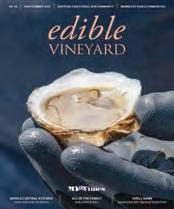
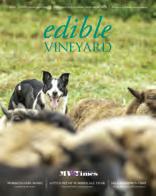

harvest 2022 5
EDITORS’ LETTER FARMSTAND HOURS: 8 AM -5 PM Closed Tue & Wed CHEESE • BEEF • PORK • LAMB • EGGS VEGETABLES • RAW MILK • BREAD • PASTRY Check out our website for winter activities THEGREYBARNANDFARM.COM COURTESY POLLY HILL ARBORETUM It’s the perfect gift!
DISHING
7 V ineyard Finds
From oyster knives to granola to coffee, we’ve found them for you.
By Gwyn McAllister
FEATURES
10 C attle calling
Island bovines live the sweet life.
By Amelia Smith
1 4 C aptain and crew
Michael Brisson leads the way at l’étoile restaurant.
By Lucas Thors
32 C elebrating high holidays
Culinary traditions from the Island’s Jewish community.
By Mollie Doyle
PHOTO ESSAY
20 Dr eaming of dahlias
Beautiful bounty from Island flower farms.
By Sadie Dix
Cover image: Randi Baird
FARM AND SEA

2 4 C atching up Net-working with Stanley Larsen at Menemsha Fish Market.
By Connie Berry
38 Smokin’ the hog Pig roasts are a harvest celebration on the Island.
By Tina Miller
ON THE FARM
28 Let us ‘sagra’ Italian culture shows us how to celebrate the harvest year-round.
By Kate Woods
IN SEASON
42 Sunda y best A roasted chicken harvest recipe for the ages.
By Tina Miller
DONE!
48 Mo ving mushrooms Tucker Pforzheimer from M.V. Mycological shares some parting thoughts.
DENA PORTER
CONTENTS
6 edible VINEYARD
FINDS
Handmade oyster knives by Colin Ruel
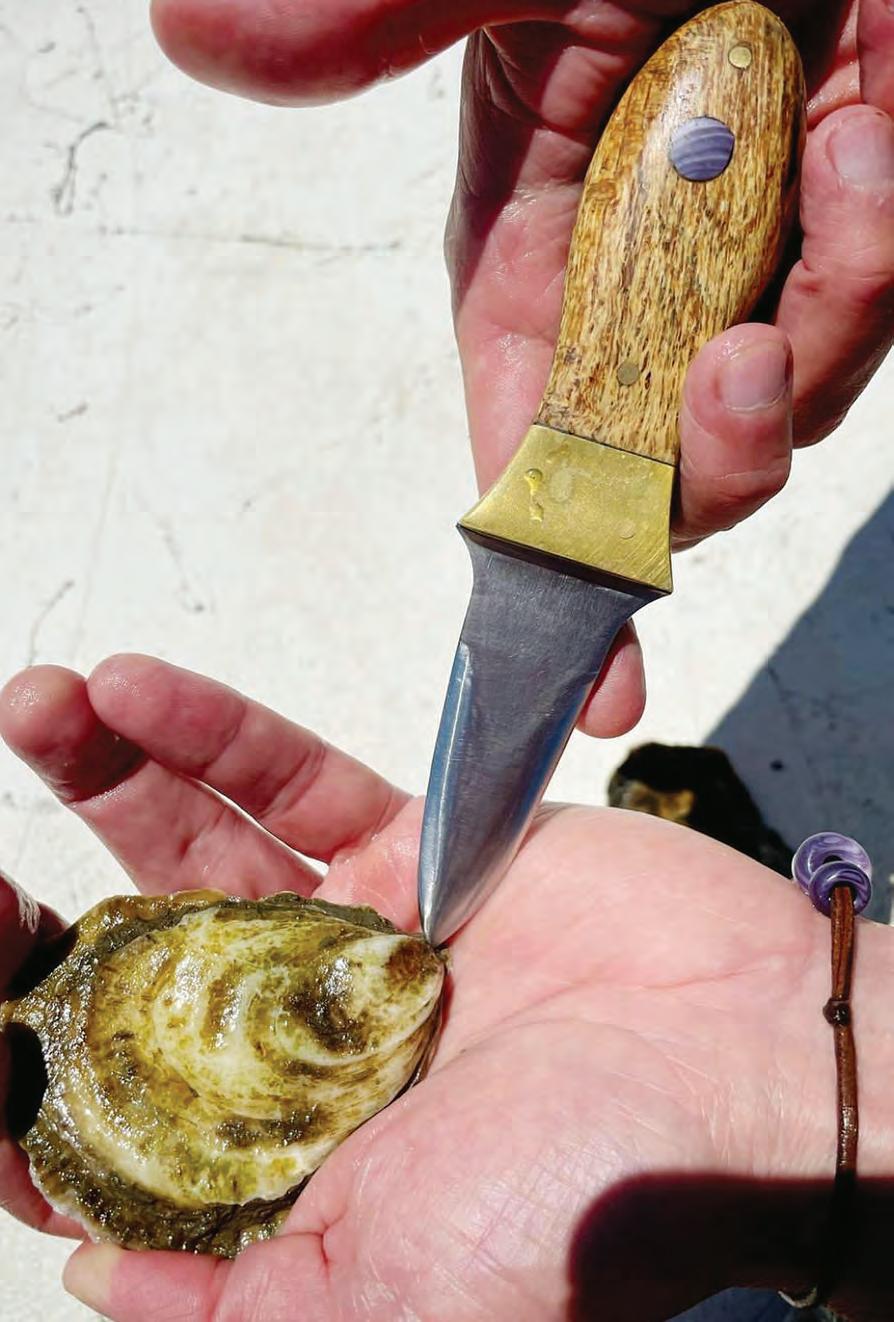
Menemsha native Colin Ruel is best known for his beauti ful, atmospheric paintings on wood panels. More recently Ruel has turned his attention to a very different sort of art form. Last year the artist
started experimenting with metalsmithing, and he is now offering one-of-a-kind oyster knives made of high-carbon steel with wooden handles.
The knives feature a variety of woods for the handles.
“I try to use wood with a local provenance,” says Ruel. These options include Chilmark ma-
ple, Vineyard oak, and ebony from the 1854 Cuttyhunk shipwreck of the Dolphin, which Ruel was able to purchase from sources on the tiny Island at the outermost reaches of the Elizabeth Islands.
Ruel, who spent some time living in Brooklyn, has also sourced some purpleheart wood
from 100-year-old New York City park benches. Purpleheart, which comes from Central and South America, is increasingly rare. Like the name implies, the hues range from brownish purple to a deep eggplant.
The handles are decorated variously with quahog shells, swordfish fins, and brass cast ings by Ruel’s wife, Nettie Kent.
The Ruel Gallery, situated in Menemsha in the building that once served as a garage for Ruel’s great-grandfather’s Mod el A Ford, features the artist’s ethereal paintings along with Kent’s hand-forged sterling sil ver and gold jewelry made from reclaimed materials. Kent’s simple yet elegant designs, like her husband’s paintings, are inspired by the Island where they both grew up. The oyster knives, which have been pur chased by oyster farmers and professional shuckers from New England and elsewhere, are the perfect complement to artwork informed by the couple’s lifelong passion for the Island.
Find Colin Ruel’s oyster knives at ruelgallery.com and on Instagram at instagram.com/ colinruel.
Martha’s Vineyard Coffee Co.
Leif Iverson knows coffee. His experience working as a barista while in college led him to ex plore Costa Rica’s famous coffee plantations, where he forged relationships within the small farming communities. This eventually led to Iverson’s desire to bring quality locally roasted coffee to the Vineyard. “I want to bring this sense of enjoyment to the Island community where I was fortunate enough to grow up,” writes Iverson on his website. “The quality of life here on the Vineyard is hard to beat. The coffee experience should be no exception.”
What makes Martha’s Vineyard Coffee Co.’s product so
The Edible Vineyard team is always on the hunt for the Island’s latest and greatest. Here are a few of our favorite finds.
WORDS Gwyn McAllister
Artist Colin Ruel lends his artistic talent to handmade oyster knives.
Courtesy Colin Ruel
harvest 2022 7
VINEYARD FINDS
superior is the way that Iverson sources his green beans for roasting. He deals exclusively with small coffee growers in Costa Rica, as well as one in Brazil. “It’s a far better practice than fair trade. You’re actually negotiating with the farmer,” says Iverson, whose mother once owned a farm in Costa Rica that he visited frequently while growing up.
Not only is Iverson supporting South American farmers, he explains how his practice of buying directly from small farms is sustain ably responsible. All of his products come from “shadegrowth” farms, which means that the beans grow under a forest canopy with tall trees and a diverse habitat. “All of the beans are grown with bio diversity in mind,” says Iver son. “There is no clear-cutting of the jungle or growing of monocrops, which can nega
tively impact the soil.”
Shade-grown beans, as Iverson explains, are also of a superior quality. “Because you’re keeping all of these native trees, it keeps the soil quality high,” he says, adding, “when you have the overstory trees providing shade, it helps the coffee ripen slowly.”
Iverson’s expertise and pas sion for everything connected to coffee is reflected in the de scriptions on the website of the various blends (or single-source) products. With the specificity of a wine expert, Iverson describes the coffees variously as having notes of “milk chocolate, toffee, sugar cookie, peach, lemon, sweet cream” or “brown sugar, honey, walnut, silky body with a sweet apple finish.”
“With small-batch roasting, you’re able to highlight the best quality and aspects of that green bean,” says Iverson. “You’re really able to capture a lot of the nuances of the origin flavor.”
Martha’s Vineyard Coffee Co. sources beans from small coffee growers in Costa Rica.
Martha’s Vineyard Coffee Co. products (bags and brewed cups) can be purchased at a number of Island stores,





bakeries, farmstands, and restaurants.You can also order online at marthasvine yardcoffeeco.com.




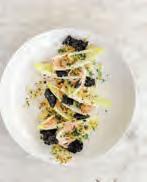 Josh Robinson-White
Josh Robinson-White
8 edible VINEYARD
VINEYARD FINDS 63 CIRCUT AVE. OAK BLUFFS, MA (508) 696-0200 | sweetlifemv.com OPEN YEAR ROUND A brand dedicated to diversity and equality ESTABLISHED 2010 SHARISSE SCOTT-RAWLINS FASHION DESIGNER SCAN ABOVE TO FOLLOW ON @BYSHARISSE
Ganola
Ganola — that’s not a typo. It’s the brand name for Erin Doyle’s all-organic granola, which she distributes to the Island Grown Initiative (IGI), the Island Food Pantry, and other Island organizations, and also offers for sale at a number of local outlets.
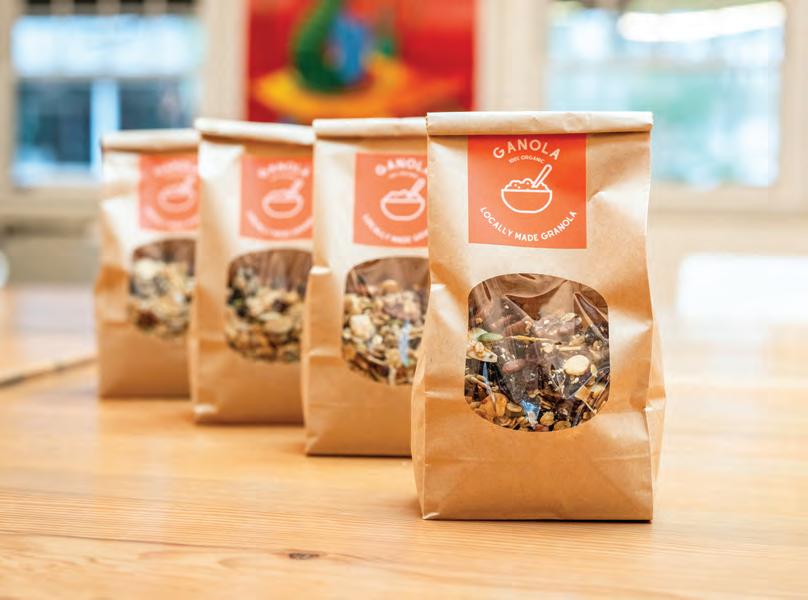
Doyle, who works with IGI, an organization dedicat ed to making healthy, local, nutritious food available throughout the community, was offered a grant in 2021 to start up her own business. Using a recipe that she devel oped with her mother, Doyle had been making granola for years to give out to friends and family.
When offered the grant, the entrepreneur knew immediately that she want ed to turn her hobby into a business while also offering a service to the Island.

With the help of Beth Kramer, a colleague of hers from the former Chilmark Chocolates, Doyle launched her business last year, and it has grown in leaps and bounds. “They can’t keep it on the shelves,” she says.
Once she decided to make large batches for distribu tion, Doyle spent a lot of time researching sources for the ingredients. Ganola is hardly your average homemade ver sion of the healthy breakfast
and snack food. There are more than 15 ingredients in every batch, and they are all organic. Eventually Doyle hopes to use Island-grown cranberries and oats. The packaging is environmentally friendly recycled paper bags.
Currently Doyle is employ ing two of her former co-workers from Chilmark Chocolates, and in the future she hopes to bring on more members of the staff from that now shuttered business, which had a long history of hiring other-abled workers during the course of
its decades-long run.
Doyle is also giving back to the community by donat ing 25 percent of the profits from each bag to the Island Food Pantry, which provides groceries and fresh foods to hundreds of families and individuals on the Island.
Now that her business has taken off, Doyle is realizing that she may have gotten more than she bargained for. She takes part in every facet of the process — from making the granola to distributing it to promotion. She’s a tireless
worker who is enjoying every aspect of the enterprise, although she says that her favorite job is the production end. Doyle has always loved to cook, and she has now turned a passion into a cottage industry.
“It’s been great,” she says. “In the summer when it was busy, it was a bit challenging, but really exciting to see it grow.”
You can purchase Ganola at the following outlets: Cronig’s Market, Up-Island Cronig’s, North Tisbury Farm Market, Ghost Island Farm, and North Tabor Farm.
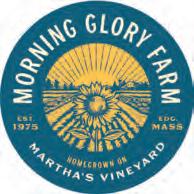
 Bags of Erin Doyle’s granola ready to be distributed and sold.
Jeremy Driesen
Bags of Erin Doyle’s granola ready to be distributed and sold.
Jeremy Driesen
harvest 2022 9 VINEYARD FINDS
Come experience the bounty We are now open year round Growing together with you, our community
www.buildingshelter.com • 508-693-7734 • info@buildingshelter.com beautiful • durable • healthy • sustainable building shelter inc. Residential Construction & Renovation www.buildingshelter.com • 508-693-7734 • info@buildingshelter.com beautiful • durable • healthy • sustainable building shelter inc. Residential Construction & Renovation
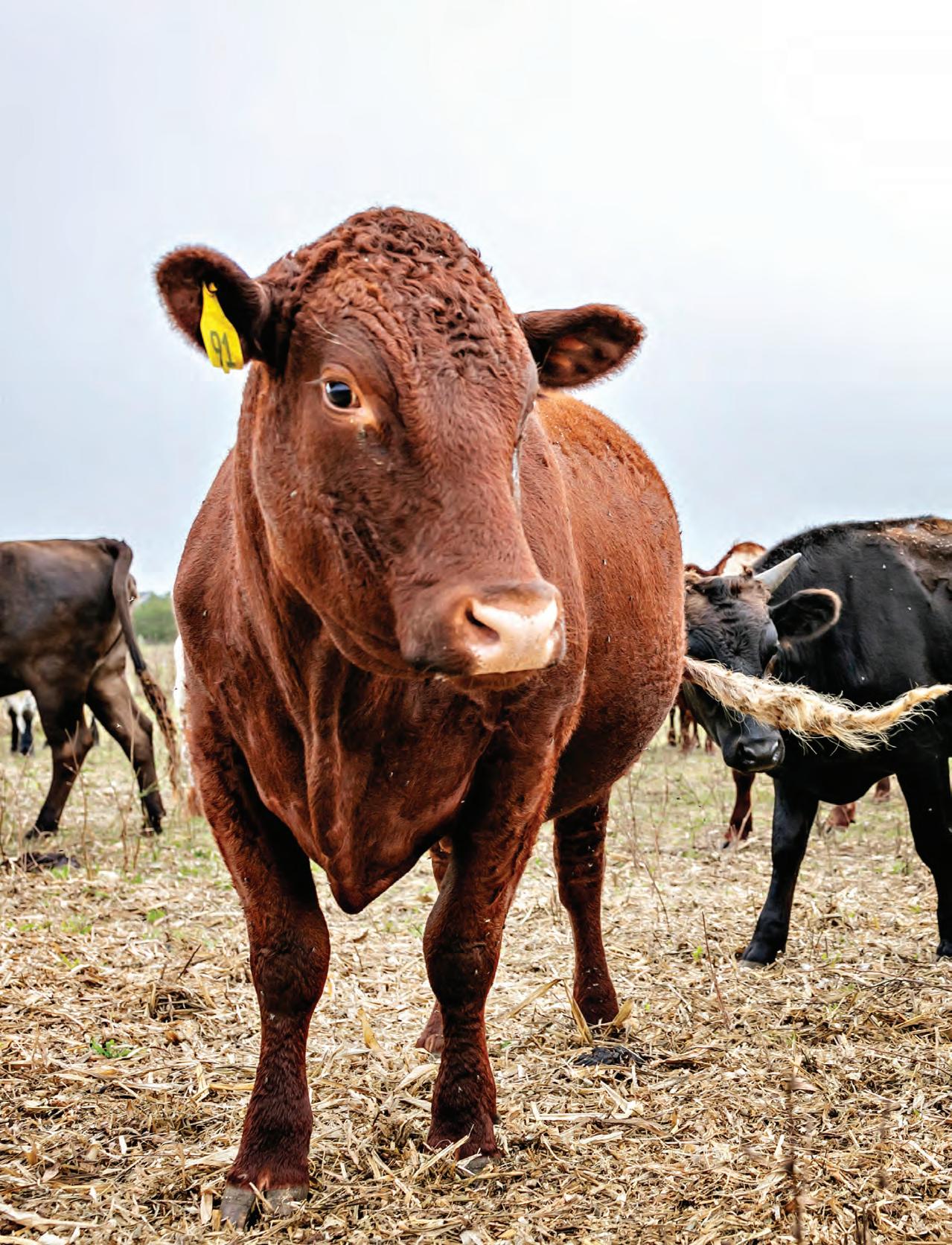
“We’re trying to promote legumes, like clover and alfalfa, and drought-tolerant grasses. Really I’d be happy with anything, as long as it’s lush. There’s a long way to go on this land.” –Dan Athearn, Morning Glory Farm
Morning Glory Farm beef herd in Katama.
Cattle FEATURE Cattle calling
10 edible VINEYARD
PASTURE-RAISED COWS LIVE THE GOOD LIFE ON MARTHA’S VINEYARD.
WORDS Amelia Smith IMAGES Randi Baird

calling
FEATURE
harvest 2022 11
Cattle calling
Cows graze on Katama’s sandy, windy pastures, enriching the sandy soil and living a life that’s quite different from that of feedlot animals raised on corn and other grains. A cow’s pregnancy lasts nine months, then it’s another two years or more before the cow is ready for market, because grassfed cows grow relatively slowly. The meat is sought-after in part because it represents more humane and ecologically conscious farming practices, as well as for its health benefits, with lower fat, higher omega-3s, and increased amounts of some vitamins.
Pastured cows contribute to building up plant life, and the grass of fertile pastures captures carbon that offsets the climatic effect of cows’ notorious methane burps. On this Island, where property prices are high, conservation land designated for agriculture helps make beef farming feasible by providing many of the acres of pastures that cows need.

“A large portion of the grazed land here is conservation land,” says Julie Scott of Slough Farm. “We have about 50 acres here owned by the Nature Conservancy. These fields have been hayed and grazed
by horses, but now we’re using it to produce food, and restore it,” Julie says. “The whole idea is to have the right number of animals, so when you get to the last pasture, the first one is ready again.” While the cows graze, other creatures make themselves at home. “People are always shocked at how many birds there are in the field,” Julie says.
“Ground-nesting birds can be in the same pasture with cows, and in winter when the cows are in the barn, the manure is com posted with other things, like food scraps, and spread back onto the pasture.”
Dan Athearn raises beef for Morning Glory Farm at Katama Farm, just around the corner. Edgartown’s Conservation
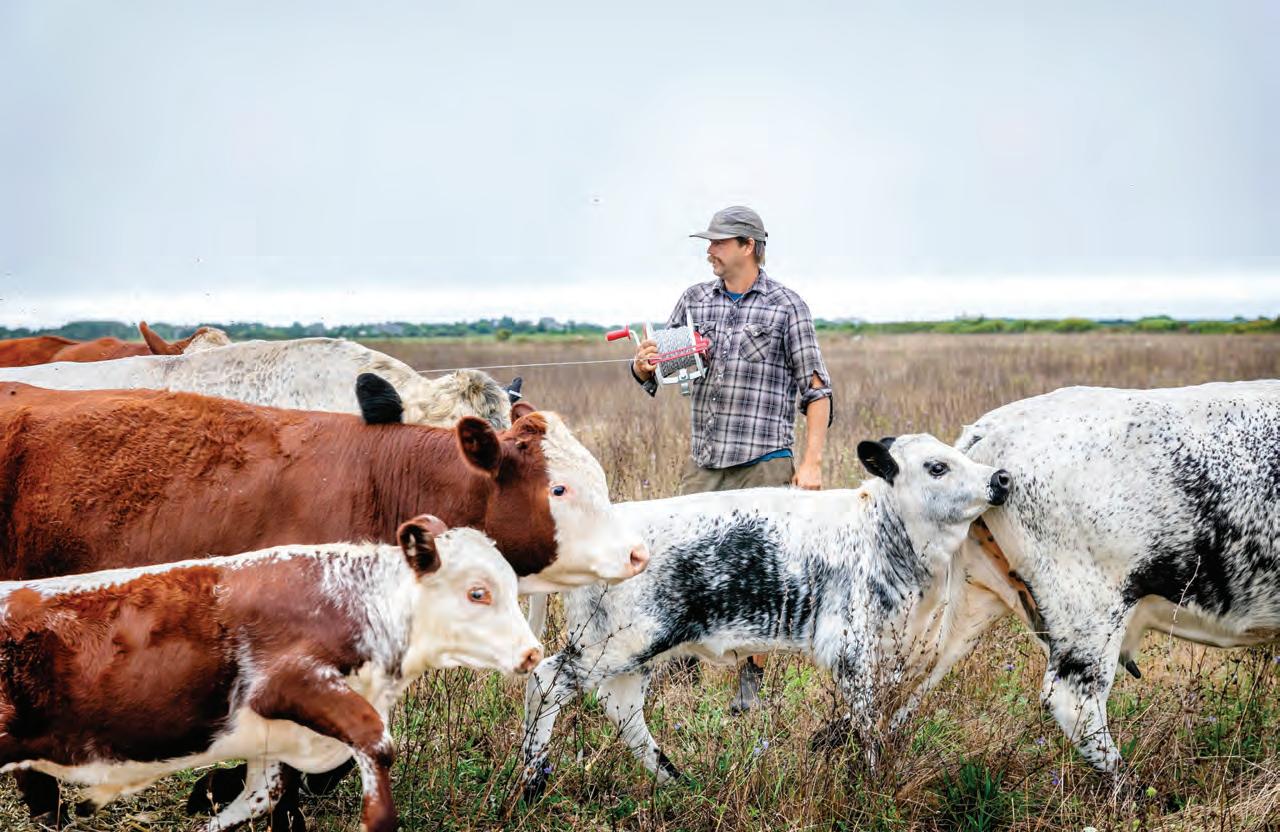 Dan Athearn with his herd in Katama.
Archie the White Park bull in Katama.
Dan Athearn with his herd in Katama.
Archie the White Park bull in Katama.
12 edible VINEYARD
FEATURE
Commission bought the 200 acres of land in 1979, saving it from being subdivided into small lots for seasonal houses. They’ve leased the farm ever since, and Dan’s father, Jim Athearn, worked on the same land when it was farmed by Seaside Dairy in the 1980s. Dan is working to improve the pasture at Katama Farm
through a process of intensive grazing.
“We pack the cattle on for a few days so they eat or trample all of the stuff you don’t want, but you need some grass just trampled, not grazed,” he says. “My experience has always been more intensive, getting a soil test and then giving it everything it needs, but that’s more of a
vegetable-centric approach.” He would like to plow some of the land, but instead he’s using it to pasture hogs, then he’ll till it and plant a cover crop. “We’re trying to promote legumes, like clover and alfalfa, and drought-tolerant grasses. Really I’d be happy with anything, as long as it’s lush. There’s a long way to go on this land.”
Dan’s cows don’t spend all year on pasture because of the lack of grass in winter and the mud in the spring. They spend the colder months in the barn and a small paddock beside it, eating hay. “It’s not uncommon not to have grass in August, because we often have dry Julys,” Dan says. “Last year was a stellar year for grazing — we had seven months of grass last year.” Some, but not all, of the cows’ hay is locally grown — Morning Glory farm grows hay at Quenames in Chilmark and in West Tis bury, while Grey Barn grows hay on some of the 40 acres they lease at Katama Farm.
Cooperation and sharing keep these small farms going, especially when it comes to breeding and building their herds. Julie started working at the FARM Institute at

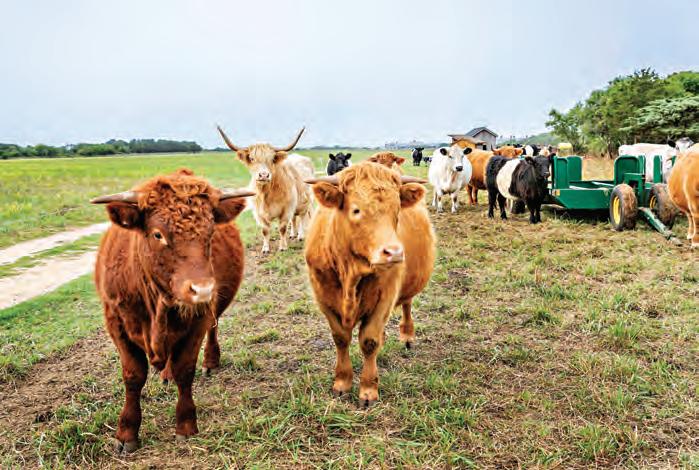
Continued on page 44
Every cow needs his hay.
The Slough Farm herd living the good life in Katama.
Cattle calling FEATURE
This captain loves his crew
 MICHAEL BRISSON
MICHAEL BRISSON
STAFF AND THE COMMUNITY FOR THE
Michael Brisson at work in the kitchen.
WORDS Lucas Thors IMAGES Nicole Friedler Brisson
CREDITS
SUCCESS AT L’ÉTOILE RESTAURANT IN EDGARTOWN. FEATURE
14 edible VINEYARD
In order to keep a ship afloat and traveling on a good heading, a few imperative elements are required: repairing the hull and mending sails so the ship doesn’t take on water or drift off course, having a strong ability to navigate rough waters, and most importantly, employing a skillful and dependable crew.
Michael Brisson, owner and cook (he doesn’t like to be called “chef”) at l’étoile restaurant in Edgartown told Edible Vineyard during a visit that the analogy of the pirate ship aptly captures the dynamic of the high-end eatery. “It’s kind of like I’m the conductor of the orchestra, but I’m also playing along with the entire group — I’m the captain of the pirate ship, but I’m just as much a mem ber of the crew,” Brisson explained as the late morning milieu of North Water Street shifted toward the lunch hour.
The story of l’étoile begins in a little grocery store on the side of the road in Pawtucket, R.I., where Brisson worked his first “actual job,” he said. “Back then they would call them greengrocers. I was like 14 years old, making $2.25 an hour because I was small enough to fit into the meat display counter and clean the blood out of the corners.”
When Brisson’s family moved out of Pawtucket, he got a job at a pizza joint called Uncle Tony’s Pizza. There, he would sit down at the end of the night with the rest of his coworkers and they would all share stories of the day, commiserate over the franticness of the evening rush, and laugh together. “There’s this kind of bunker men tality where you make it through the night together — the comradery, the beer mugs pulled out of the freezer full of Coca-Cola, we were a team, a crew,” Brisson said.
The supportive nature of his manager at the pizzeria struck a chord with Bris son. He noticed how much the manager supported and encouraged employees to do their best and be their best. It’s a lesson Brisson has carried with him all the way up to today, as he seeks to do the
same with his crew at l’étoile.
There are a few moments Brisson can recall in his life where he became en tranced with delicious food, moments that helped put him on the trajectory toward making a living doing what he loves. By the time he was 16 years old, Brisson was asked by the assistant manager of Uncle Tony’s to work in a new restaurant he was opening in Smithfield, R.I. On occasion, Brisson would stir the spaghetti sauce at the new restaurant as it was being made. “I would be stirring, and I would take some plain bread and put some sauce on it. Man, I just absolutely loved that,” Brisson said.
Brisson grew up as one of six kids. Both his parents were hard workers, and sometimes his mother would make a special meal that he thoroughly enjoyed. But Brisson’s first food epiphany occurred when he was very young, while hanging out at his friend’s family home. “Back then, apart from once in a while when my mom would make something really tasty, eating was a bodily function — it wasn’t a joyful moment,” Brisson laughed. “When I was at my friend’s house and his mother gave me some frozen peas boiled in saltwater and tossed in some butter, I was absolutely blown away. We didn’t have butter growing up. I had Mazola, I had margarine.”
After trying out college for a semester, Brisson realized that his passion was in the kitchen. In 1978, he was helping run an Italian-Hungarian restaurant in Rhode Island, and the restaurant’s owner had an opportunity to buy space in the Charlotte Inn. Brisson fell in love with the Island immediately, and became the sous-chef of the restaurant, Chez Pierre. By the time he was 18 years old, he was running the restaurant largely on his own.
Brisson knew he wanted to expand his culinary abilities to encompass every as pect of working in fine dining, so he left the Vineyard and worked in several high-end restaurants on the mainland, eventually rising to the level of chef de cuisine under the tutelage of world-famous chef Moncef Meddeb. “Meddeb told me one day, ‘You

“I have the best crew I have ever had in 35 years. I have hired kind, considerate, hardworking, mindful people.”
–MICHAEL BRISSON, L’ÉTOILE RESTAURANT
This captain loves his crew
harvest 2022 15
FEATURE
will open your own place, I know you will,’ and that really set me down this road to where I am now,” Brisson explained.
Eventually, the space at the Charlotte Inn that his old boss purchased became available, and Brisson knew it was his time to forge his dream. He took over at the inn, and in 2005, Brisson moved his restaurant to its current location on North Water Street, and continued sailing his own ship.
For Brisson, comfort, attention to detail, and quality ingredients have always been mainstays of l’étoile. But the most important aspect of the dynamic dining experience in downtown Edgartown is teamwork.

Especially during the worst days of the COVID pandemic, Brisson needed a dedicated and passionate crew in order to
relevant as a restaurant, and not shaking things up too drastically too often. “I never want someone to walk by my restaurant and say, ‘Oh, it’s that old place. That place has been the same for years.’ At the same time, it’s hard to be constantly updating and changing menus. It takes a lot of time and work,” Brisson said.
But the old saying “don’t fix what isn’t broken” applies to the l’étoile menu, as some timeless classics have remained, and have become representative of the kind of cuisine folks can enjoy there. Although some newer items like the grilled octopus and chilled golden tomato gazpacho are huge hits, any Edgartonian (or Islander who’s eaten at l’étoile) will advise you to try the foie gras. “The octopus is something
moving. He said his harmonious and hardworking staff have time after time taken the initiative to have their own influence in how the business operates, and he always encourages that and offers opportunities to stand out. “When I built the brand-new bar, I basically handed it over to Lola and the rest of the bar staff, and told them to make it their own. I say, ‘I’m not a bartend er, you are professionals, take charge,’” Brisson said. “They did so incredibly — it’s called taking pride in your work, and it goes far in any profession.”
Apart from his staff, Brisson pointed out some folks in the community who are also helping his business and businesses like his survive and thrive. “We really have so many good people on this Island who keep us going: Seth Williams, my electrician Chris Greene, my massage therapist, my chiropractor, the guy who built my bar, Andrew. The support people here who are keeping all of us restaurants going, those people are stars,” Brisson said.
He thanked all his food providers who always get him fresh ingredients, like the folks over at Net Result who supply beautiful cuts of fish regularly. Whenever he gets a cut of fish, Brisson said he treats it with the utmost respect when turning the raw product into a delicious, gourmet meal. “I make sure to send the folks at Net Result pictures every now and then of the finished meal, and I say, ‘Thank you so much for this beautiful fish,’” he said.
weather the storm. While some restaurants and businesses were hiring “warm bodies” out of sheer desperation, Brisson said, he continued to be highly selective in whom he brought onboard. It’s a decision he said he has never regretted, and many of the folks he hired several years ago still work for him.
“I have the best crew I have ever had in 35 years. I have hired kind, considerate, hard working, mindful people,” Brisson said.
Over the years, l’étoile and its staff have adapted to a constantly changing business environment — one thing that Brisson said they’ve gotten pretty good at. Additionally, Brisson has always worked hard to walk the thin line between remaining fresh and
I’m really proud of because I’ve never done it before, but I do specialize in foie gras, and people really enjoy that,” Brisson said.
Brisson also loves preparing other duck dishes, along with lamb, lobster, and gnocchi. For him, it’s all about making the experience memorable and unique. “I make food I want to eat, and I make food that you really don’t make at home. That’s why you don’t see a pork chop on the menu,” Brisson laughed. “And you don’t normally see people making foie gras at home, unless you want to set off every smoke detector in your house.”
Brisson gave a shout-out to all the different people who keep l’étoile’s machine
In that same vein, Brisson general ly doesn’t associate his name with the business, although he is a well-known face around the Island, especially in Edgartown, where passersby constantly greet him as he sits on l’étoile’s porch. For Brisson, the val ue and identity of l’étoile is the restaurant, the food, the staff, and the experiences the entire package provides. At some point in the future, he hopes to walk away, and pass the restaurant on to someone who cares just as much about great food as he does.
At this time in his life and his career, Brisson said he is proud to have built a busi ness that has weathered the test of decades, a COVID pandemic, and all sorts of other curveballs. But above all, he said, he is hap py to provide both locals and visitors with enjoyable experiences and delicious food.
“There is such a sense of community and home here on the Island. I have people who eat at my restaurant all the time, and I have people who are eating here for the first time — it doesn’t matter as long as they’re smiling when they walk out the door.”
The bar at l’étoile in Edgartown.
FEATURE This captain loves his crew
16 edible VINEYARD
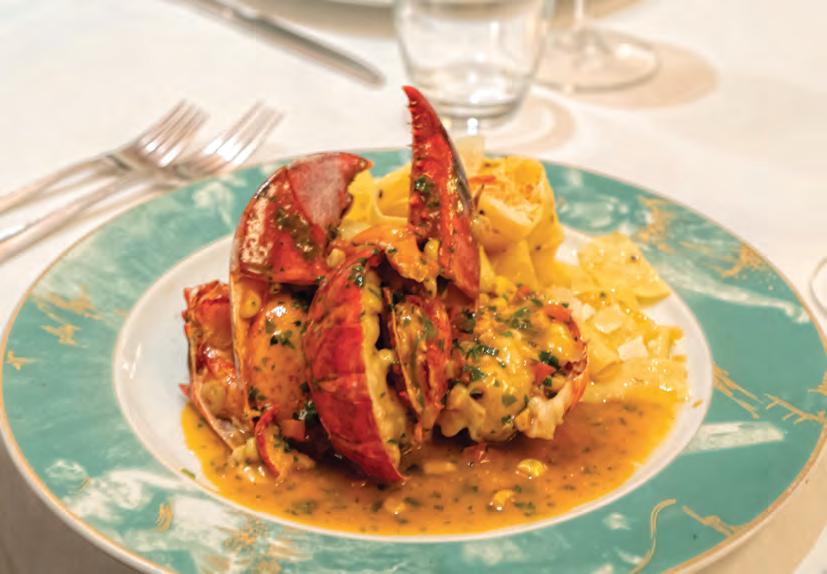
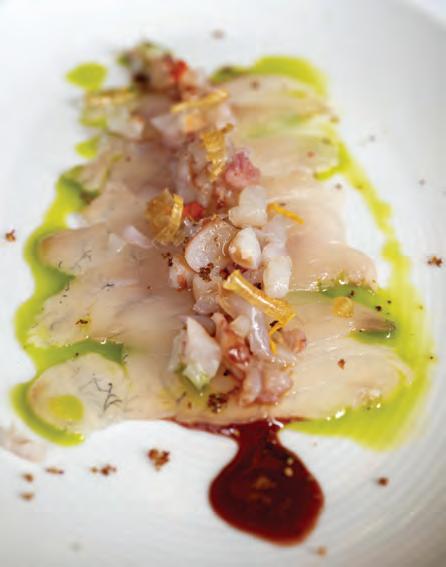
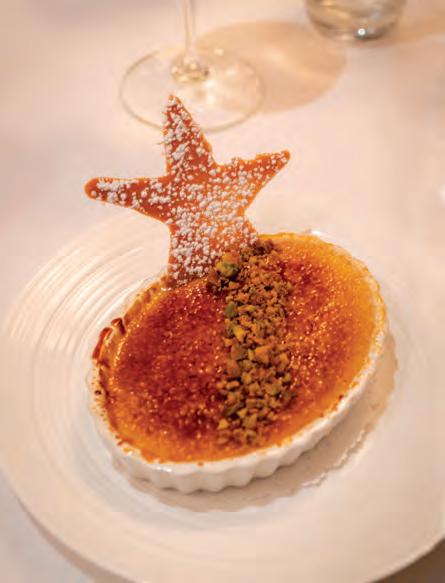
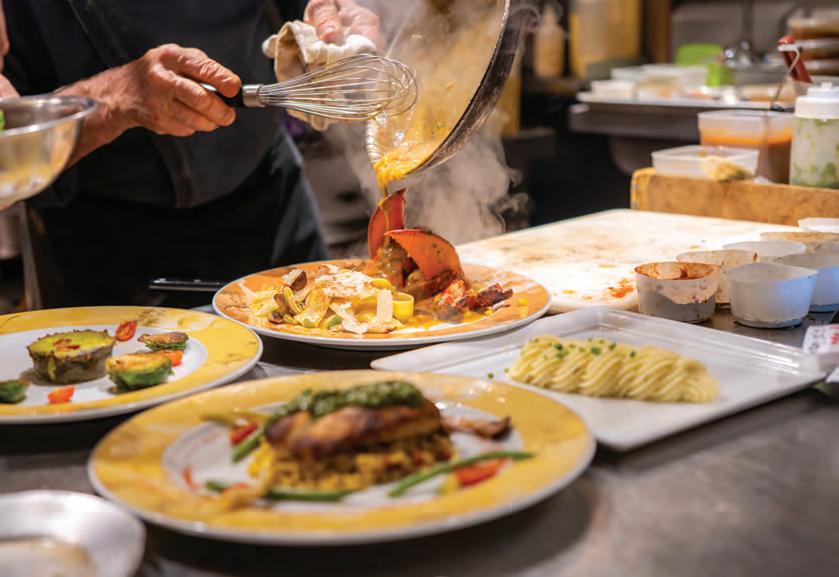
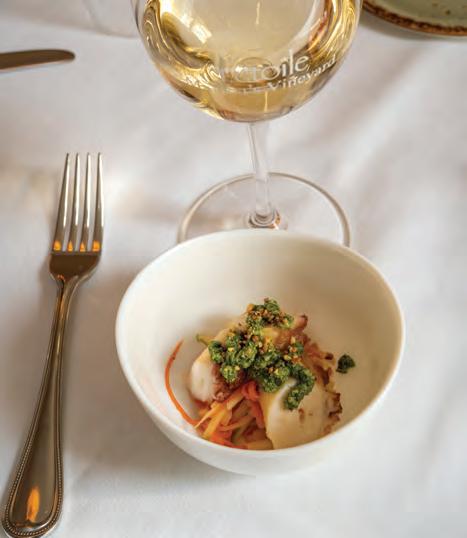
 Étuvée of Menemsha Lobster
White Chocolate and Grand Marnier Crème Brûlée
Tautog Crudo
Prepping the dinner plates in kitchen.
Grilled Filet Mignon
Grilled Spanish Octopus
Étuvée of Menemsha Lobster
White Chocolate and Grand Marnier Crème Brûlée
Tautog Crudo
Prepping the dinner plates in kitchen.
Grilled Filet Mignon
Grilled Spanish Octopus
FEATURE
Baking muffins
Muffins can be the perfect portable grab-andgo breakfast snack, or an afternoon treat with tea. But today’s commercial muffins are often very sweet, making it hard to pretend you are not eating cake for breakfast. And some people cannot eat baked goods because they are dairy-intolerant, or have gluten sensitivity or celiac disease.
But fear not, baking options have come a long way, and it is now simple to create baked goods at home that you can live with.
Cronig’s Markets has a diverse selection of baking flours and grains, from companies like Bob’s Red Mill, King Arthur, and Pamela’s. They also have many creative gluten-free quick mixes for treats like cookies, brownies, and cakes.
This Cranberry Orange Corn Muffin recipe is dairyfree and less sweet, with no sugar, but sweetened with pure maple syrup and orange juice. These muffins are a bit heartier, with gluten-free corn grits (coarse cornmeal) and gluten-free oat bran that add fiber and protein, leaving you feeling more full. With these changes, the muffin may actually be a semi-healthy grab-and-go option.
Cranberry Orange Corn Muffins

Makes 10 large muffins
Dry ingredients
1¼ cup gluten-free flour (we used Bob’s Red Mill Baking Flour)
1/2 cup oat bran
1/2 cup coarse cornmeal
1½ tsp. baking soda
1 tsp. baking powder 3/4 tsp. salt
2 eggs, room temperature

1 tsp. vanilla extract
1/3 cup light oil, such as sunflower oil
1/2 cup maple syrup
1/2 cup fresh orange juice
grated zest of one orange
1½ cup fresh or frozen coarsely chopped cranberries (if frozen, do not thaw)
Preheat the oven to 350°, and lightly spray the muffin pan with nonstick spray. Mix dry ingredients in a separate bowl.
Using a stand-up mixer with paddle attachment, beat eggs, add vanilla, add oil and maple syrup. Beat until well combined. Stop and add orange juice and zest. Combine.
With the mixer on low, slowly add the dry ingredients. Scrape sides and combine. Slowly add cranberries. Once everything is incorporated, you are done mixing.
SPONSORED BY CRONIG’S Ladle batter into muffin pan, and bake for about 25 minutes, turning the pan halfway through for even baking.
This story and recipe was brought to you by:
Think outside the box, and try this gluten-free baking option.
18 edible VINEYARD








































Dreaming of dahlias
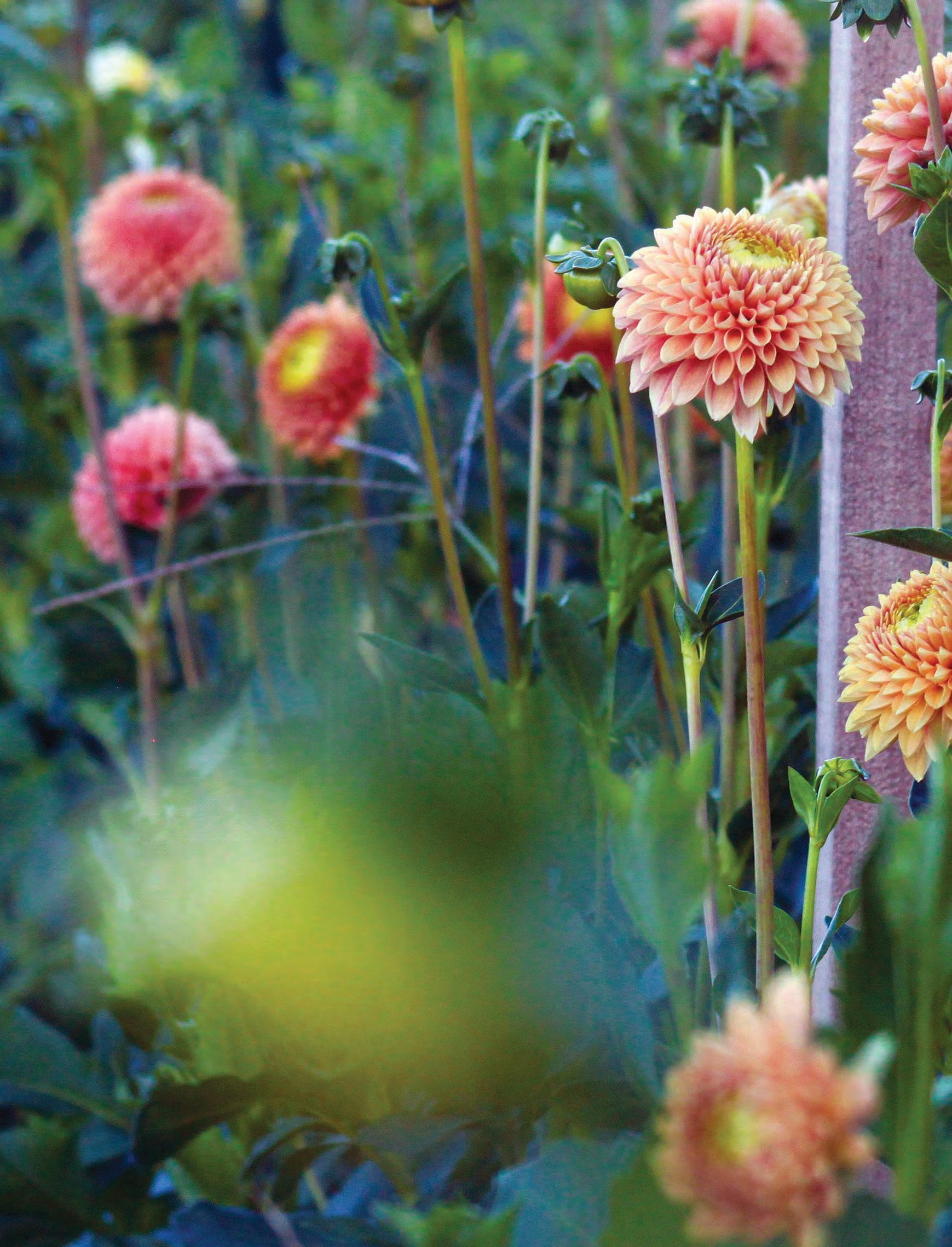 IMAGES Sadie Dix
PHOTO ESSAY Dreaming of dahlias
IMAGES Sadie Dix
PHOTO ESSAY Dreaming of dahlias
20 edible VINEYARD
According to the American Dahlia Society, dahlias are the longestblooming flower in cultivation.



Dahlia is a bushy, tuberous, herbaceous perennial plant native to Mexico and Central America.
In the past decade, dahlias have come
into their own on the Vineyard. Perhaps it’s the hardy diversity, with so many different flowering options, up to 42 species, growing up to 8 feet tall and in every color, shape, and size you can imagine. Photographer Sadie Dix captured these dahlias at Tea Lane Farm and Fire Cat Farm.

harvest 2022 21



 PHOTO ESSAY Dreaming of dahlias
Sadie Dix
PHOTO ESSAY Dreaming of dahlias
Sadie Dix
22 edible VINEYARD
Are you curious about nature?
Are you curious about nature?
Join our community-science effort to catalog the biodiversity of the Island!
Join our community-science effort to catalog the biodiversity of the Island!
Join our community-science effort to catalog the biodiversity of the Island!




Visit our website to learn about local plants and animals. Share your sightings and connect with others.
Visit our website to learn about local plants and animals. Share your sightings and connect with others.
Visit our website to learn about local plants and animals. Share your sightings and connect with others.
mval.biodiversityworksmv.org
mval.biodiversityworksmv.org
mval.biodiversityworksmv.org
CATCHING UP WITH
Stanley Larsen
Spend some time net-working at the Menemsha Fish Market.

WORDS Connie Berry
If you're looking for an authentic New England fish market, you have to drive the winding way from down-Island to Chilmark and the Menemsha Fish Market. This is not a glitzy water-resis tant-wood-floor sort of space, with fancy takeout containers and artisanal accompaniments. More like a very well-worn painted concrete floor that you could hose down in a pinch, and a cold case holds all sorts of seafood treasures . . . fresh sea scallops from the Martha Rose, which you can see docked right outside. Swordfish, codfish, halibut,
fish cakes, stuffed quahogs and a whole lot more. Lobsters crawl over each other in the big tanks next to the packed cold cases. It's enough to make you want to grab your waders. What makes the mar ket genuine though is the man behind the counter, Stanley Larsen.
Born and raised on Martha's Vine yard, Stanley works just about every day dawn to dusk. He only recently stopped going out on his fishing boat, Four Kids, and hauling in his own daily catch. It's too difficult to find someone to go out with him these days, he said. He buys from local fishermen and some fish out of Bos
–STANLEY LARSEN

Swordfishing was my favorite. I caught a 500-pounder the day my son Eric was born. It was the only fish caught by the whole fleet that day.”
The big yellow sign lets you know you've arrived at the fish market.
Stanley Larsen takes a break outside the fish market.
24 edible VINEYARD FARM AND SEA
PHOTOS: JEREMY DRIESEN
 Catching up with Stanley Larsen FARM AND SEA
Catching up with Stanley Larsen FARM AND SEA
harvest 2022 25
2
1. Fishermen climbing up the rigging to take a look.

2. Deck covered with dressed swordfish, and the deck is filled because the bin below was full.
3. Fishing the old-school way.
4. Hauling in swordfish.
ton, with swordfish coming mainly from Canada, halibut from Newfoundland, and salmon from the Faroe Islands.
We caught up with him at the fish mar ket on a busy sunny afternoon in September. Despite the warmer days of summer waning, the place was packed.
“Swordfishing was my favorite,” Stanley says while he takes a quick break from packing up lobster to ship off-Is land. “I caught a 500-pounder the day my son Eric was born. It was the only fish caught by the whole fleet that day.”

Back when swordfishing was done regularly with spotters and harpoons, Stanley was out there with his dad, Dagbard, and guys he's known his whole life. “With my father, we caught a fish dressed out at
622 pounds, that was 1976 or so,” he says. There were no touch screens on the boat to connect to your personal tech devices. You climbed high up on the mast and kept your eyes peeled.

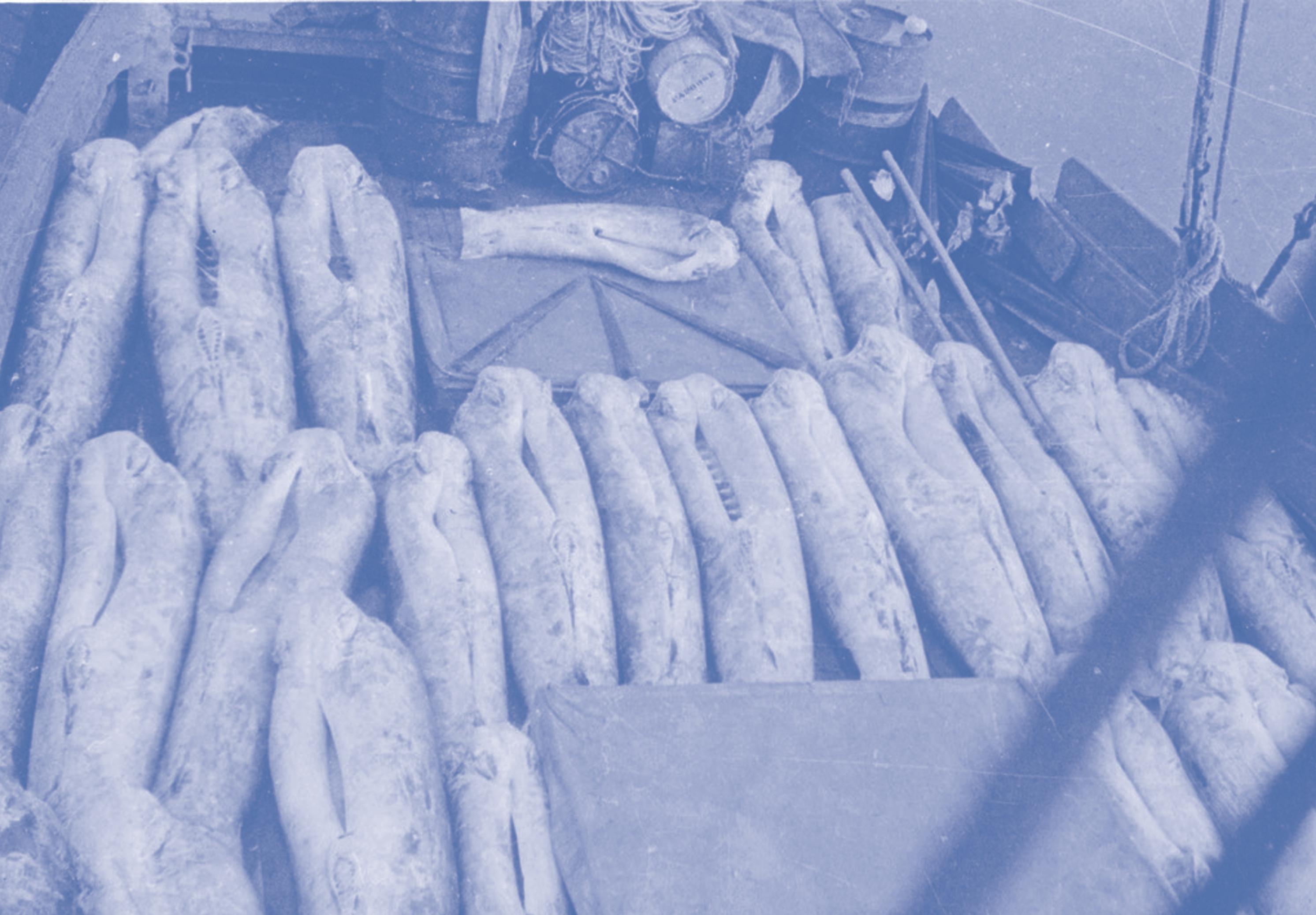
To this day, though, swordfish is Stanley's favorite seafood.
“I like it grilled but I like it poached too, like salmon.”
The fish market has been operating since the 1940s when Everett Poole ran it. He passed it down to his son, Donald, and then Stanley and Lanette, his wife, took over in 2004. His daughter Janelle has worked there since she was 7, Stanley said. And although he's been in the business of fishing his whole life, it's still hard to keep up with him while he's at work behind
the counter, ready with a wave and a few welcoming words for nearly everyone who comes in the door.
“Do we have any 3-pounders?” an em ployee calls out to Stanley. “Yeah, we've got 'em,” he says. Another employee tells a customer how tasty the stuffed qua hogs are and other staff are in the back in the kitchen ladling out the market's awardwinning clam chowder. If you ask Stanley, he'll tell you everyone loves it so much because it's so full of clams.
“Chowder-making is a team effort, but yeah, it's pretty much my recipe,” he tells me. “You start with a base, and we put a lot of clams in it. The bisque — many, many people tell us it's the only bisque that tastes like lobster. People
FARM AND SEA Catching up with Stanley Larsen
PHOTOS COURTESY WILLIAM SMITH
26 edible VINEYARD
1 4
3
come from all over the world and say this is the best bisque they've ever had.” (Even though the chowder is delicious, it's the bisque filled with huge lumps of lobster meat that gets my attention every time I make the trek out to Menemsha.)

A customer rolls through the door with a wheelchair. His name is Bill Smith and he tells me he’s known Stanley since kindergarten, around 60 or so years ago now. His dad was the fire chief in Chil mark and he and Stanley’s uncle were best friends, Smith says.
“Stanley and I grew up when 12-year-old kids walking down the side of the road with a .22 and a handful of rabbits was normal,” Smith tells me. “When Stanley and I went to high school, the only thing we wanted to
Stanley and I grew up when 12-year-old kids walking down the side of the road with a .22 and a handful of rabbits was normal.” –BILL SMITH
do was to get home and get out in the woods. You know, he’s the hardest-working man in town, and one of the few open all winter and
that’s quite a feat around here.”
This conversation takes Stanley back too, and Bill says to him: “Your fa ther and uncle came in with two weeks worth of swordfish, back when there were fish around.”
“I feel pretty fortunate,” Stanley says. “I grew up right here — like Billy coming in here — I see my friends on a regular basis. My whole family pretty much lives on the Island.” Later he points to a grove of trees out past the marshlands in front of the market and tells me that he used to live in a house right over there, and when he was growing up he and his friends loved to camp out under the stars. “You kind of still can,” Stanley says, “but you’ve got to be a little more careful.”
1. Stanley and Lanette Larsen with their daughter Janelle Fogg. Janelle has worked at the fish market since she was 7 years old.
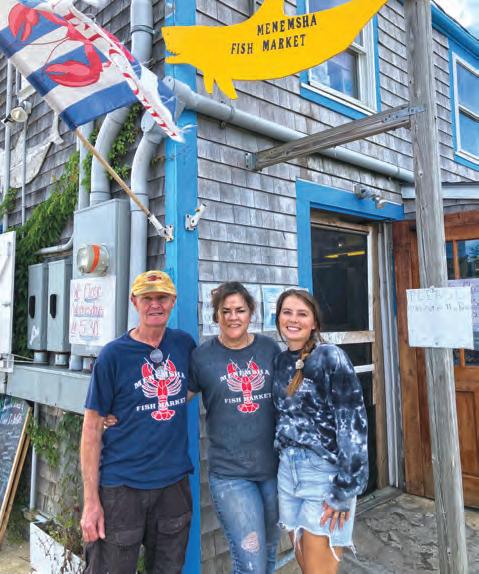
2. Well, howdy there, Mr. Lobster.

3. At work behind the counter.
4. A bowl of chunky clam chowder from Menemsha Fish Market.
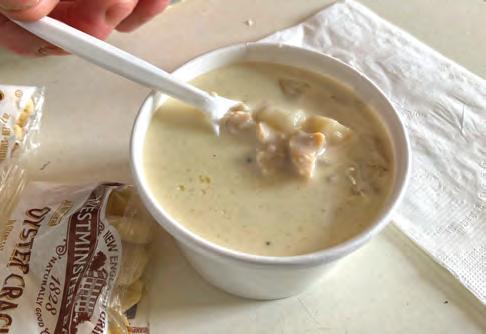 Catching up with Stanley Larsen FARM AND SEA
Catching up with Stanley Larsen FARM AND SEA
harvest 2022 27
PHOTOS : 1, CONNIE BERRY; 2, JEREMY DRIESEN; 3, JEREMY DRIESEN; 4, CONNIE BERRY 1 4 2 3
LET US ‘SAGRA’
Italian culture shows us how to celebrate the harvest year-round.


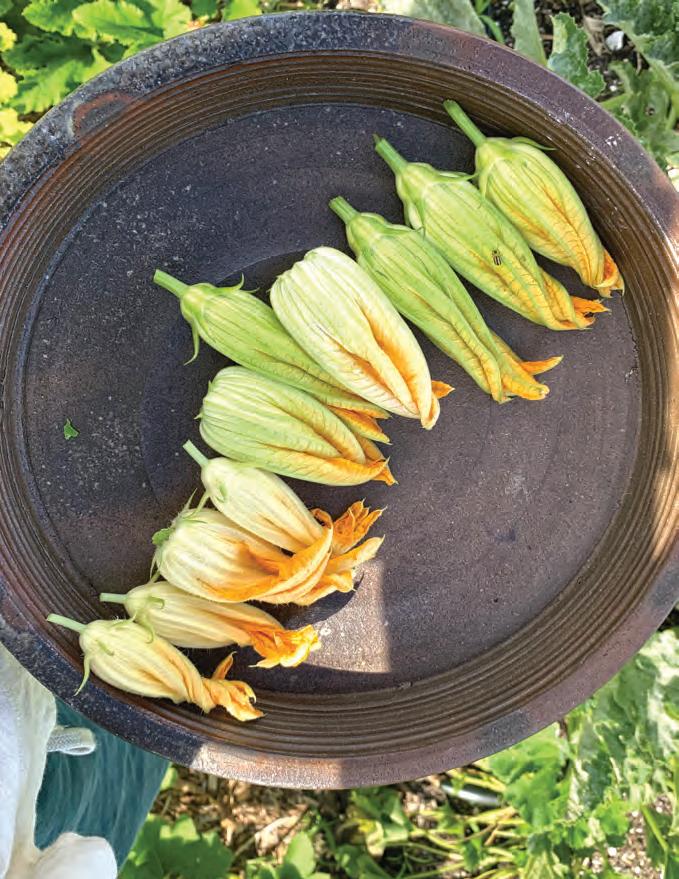
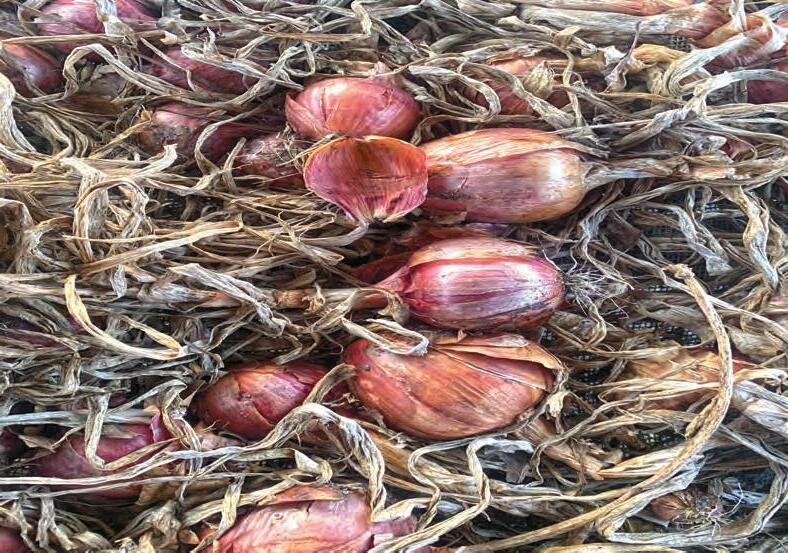 ESSAY AND IMAGES Kate Woods
Squash blossoms ready for an Island restaurant.
Homegrown artichokes are best.
Harvested fava beans.
Red onions for the pantry.
ESSAY AND IMAGES Kate Woods
Squash blossoms ready for an Island restaurant.
Homegrown artichokes are best.
Harvested fava beans.
Red onions for the pantry.
28 edible VINEYARD ON THE FARM
How do you mark the passing of time? Is it by the changing temperature, by the observed annual holidays, by the school calendar, or perhaps by what you’re eating? As a farmer, I fall into the latter category. Not just because it’s been ingrained in me from years of farming, but because moments of eating and sharing food with others have always been the richest with connection and narrative, in my experience. It’s never been simply about what’s on the plate. It’s where you are while eating it, where and who the food came from, how it was grown, its genetic history and, of course, whom it’s shared with. In a post-agrarian society, however, these deeper contextual considerations seem less valued, less celebrated. And understandably so. Grocery stores providing us with any food we could possibly want at any moment have numbed us to the plea sures of limited availability that come with regionality. I’d argue that in such a contemporary, digitized world, re-engaging with the food system and the inherent cycles associated with regional seasonality would be deeply impactful for us all. It is a tangible, satiating, and viscerally enjoyable pursuit that deepens our connection to the natural world and to each other.
To gather around food is to experience one of the purest forms of joy. It’s a moment, perhaps one of the few, to leave behind our busy lives and to gather. From my somewhat brief time here as part of the community, I’ve noticed more aware ness around this ritual than in most of the places I’ve lived before. At the Farmers Mar ket each Saturday, we farmers have a frontrow seat to the prelude of many people’s nightly culinary congregations — some even giddily sharing their supper menu with us as they check out. I watch as so many people come and go — each with a unique shopping agenda. Some come for the coveted first pints of cherry tomatoes, others for bread and pastries, and most for chocolate. But the commonality seems obvious — people crave community, they crave entertainment, they crave good food. I wonder sometimes, when the market crowds subside, and my mind has a chance to wander, Is there a way to dig even deeper into these desires? Is there a way to bring more light to the farm, the farmers, the fishermen, and other purvey ors? Is there a way to celebrate the passage of micro-seasons on the Vineyard, taking a
moment to appreciate the fleeting, unique provisions that each moment brings?
Enter Italy. A country so good at cele brating food moments that every region of the country has at least one festival each month to honor a seasonal food product or wine. These feasts are called sagre, and they typically celebrate an individual har vest of something regionally noteworthy. It aly’s extensive list of different sagre include (but are certainly not limited to) chestnuts, olive oil, polenta, artichokes, eggplant, and wine, of course. Can you imagine? Instead of June, let us celebrate the month of peas. For get September; leek month sounds a whole lot better to me. Lane Selman and her team at the Culinary Breeding Network, based out of Portland, Ore., are making moves to bring the spirit of the traditional Italian sagra to the U.S., having hosted their own Sagre
around winter squash, beans, and their most evolved, Sagra del Radicchio. Much like their Italian forebears, these events are centered around building community. Participants learn about various culinary preparation methods of the highlighted vegetable. Further education covers best growing practices. Finally, and perhaps most importantly, historical content and celebratory storytelling transmits the what and why this vegetable is so special. The lineage of its breeding, the uniqueness of its growing region, those characteristics that are worth understanding more, and taking pause for. In reflecting on her favorite part of the tradition of sagre, Lane writes, “It was pleasure with a sense of purpose and creativity, a feeling of community reinvest ment in a food system that, in the United States, has long felt divorced from everyday life — hidden away behind a curtain.”
We’ve been fortunate enough to enjoy a handful of dinners on the farm this year with friends and family. Each one of these dinners represented a very specific moment in time
during the growing season, based on what vegetables were being shared. Though none of them zeroed in on one specific harvest item, each did serve as an excuse to gather people around a table to honor a farm and the food that it provides a community. We highlighted the veg we were proudest of at that moment by caramelizing ‘French Grey’ shallots and serving them with local sea scallops. We roasted the sweetest of ‘Corno di Toro’ red peppers to make romesco, and we utilized a bumper crop of Genovese basil to mortar-and-pestle endless versions of pesto. However idyllic this may sound, what I found just as valuable during these dinners was to share some of the other, not-so-celebratory realities of the growing season this year at Beetlebung Farm. Our spring carrot seedlings succumbed to pill bugs, our kale had terrible flea beetles, preventing us from harvesting it at all, and the Island (and much of the Northeast) suffered terribly hot and droughty weather that stressed many of our crops to the point of fail ure. These are all important aspects and realities of farming, ones that the community only becomes aware of if they ask, if they visit, or if they share a meal with a farmer. These narratives, good and bad, provide the connective tissue that add depth and understanding to the local food ecosystem. They add even more rea son to celebrate the successes and the ability to feed each other, because, wow, farming is hard.
The idea of one singular “harvest season” is a misnomer for me. On the farm, we harvest something new every month. Each vegetable has its own significance to that particular time of year, to the land, and to our diets — each deserving of its own attention and appreciation. We shouldn’t be celebrating the harvest once each year, but constantly, and for every moment that marks a new vegetable, fruit, fish, meat, or cheese coming into our lives. Yes, through community-supported events as much as possible, but even small ways, amongst family, are important. Taking pause. Appreciating the moment. Grounding us to this place and time, sharing them with those we’re with, these fleeting products of the natural world. Let us honor the food grown so close to home in ways that protect our soil, let us celebrate the coming together and building of community around an outdoor table, let us expose one another to the truths of farming, let us sagra.
To gather around food is to experience one of the purest forms of joy. It’s a moment, perhaps one of the few, to leave behind our busy lives and to gather.
harvest 2022 29 Let us ‘sagra’ ON THE FARM
WILD THINGS
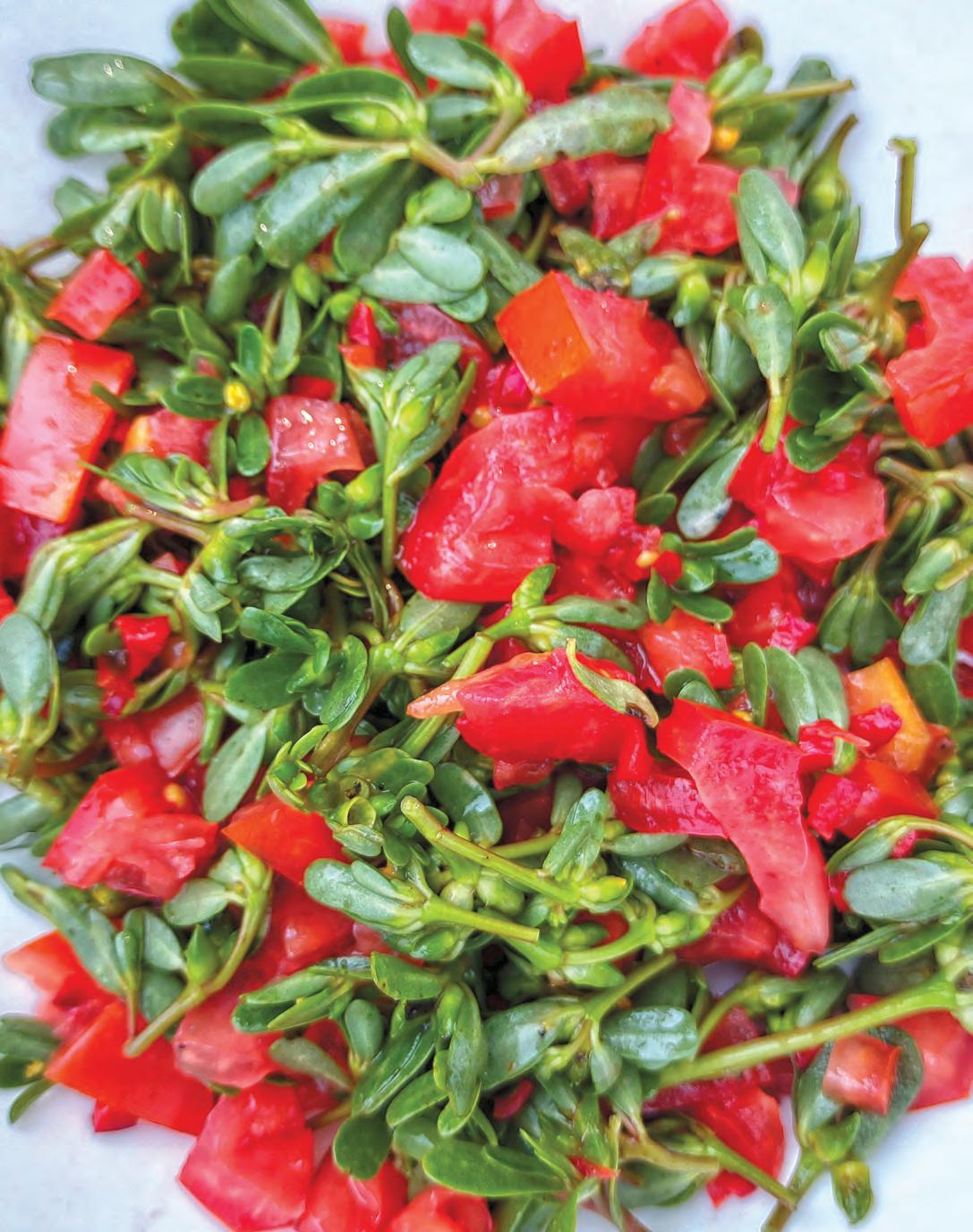 Purslane Salad, tossed and ready to serve.
Rebecca Randall Gilbert’s new book gets us out into the woods.
WORDS Mollie Doyle IMAGES Rebecca Gilbert
Purslane Salad, tossed and ready to serve.
Rebecca Randall Gilbert’s new book gets us out into the woods.
WORDS Mollie Doyle IMAGES Rebecca Gilbert
30 edible VINEYARD BOOKS
There is so much to admire about Rebecca Randall Gilbert’s “Weedy Wisdom,” particularly because it was born out of community, curiosity, and a profound respect for our natural world, which are three things I deeply appreciate. There is also the fact that the book stands on its own. So while I live a stone’s throw from Rebecca’s Native Earth Teaching Farm and could easily go talk to her, I don’t feel the need to get more explanation as to why or how she wrote the book, nor do I feel a need for clarification of its contents. Pretty amazing, right?
But let me back up for a moment and give you a few waypoints on what it is, and why it is so important to have a copy of this gem of a book on your bookshelf. Gilbert’s book grew out of a collaboration and forag ing class with Camp Jabberwocky, which was initiated by a question from a man named Scott: “Do you have any medicinal plants in your garden?” To which Rebecca replied, “I like to use weeds.” The book is based on eight classes on foraging where Rebecca explains why people might forage and how. Lunar and solar harvesting tech
niques, history, and recipes are sewn in.
My first experience with foraging was when I was a child, and my mom’s friend Julie Boegehold taught me some wild mush room hunting basics (with a lot of cautionary tales!). She gave me the “Audubon’s Field Guide to North American Mushrooms,” and showed me how to identify them by taking spore prints with brown and white paper. On our first venture out, Julie and I found a huge chicken of the woods growing on the side of a tree. Julie was gleeful. We sautéed the mush rooms with some shallots and fresh thyme, and folded them into omelets. The mush rooms were heaven. And it felt so special to be able to march out my back door and find food in the wild that we could eat. Since then, I’ve foraged all over the place — looking for greens while backpacking in the Wyoming and Colorado wilderness, crunching on lamb’s ears in New Hampshire and Vermont,
Purslane Salad
1 cup purslane tips, rinsed

1 large old-fashioned tomato: cut in half, most of the juice and seeds squeezed out, and coarsely chopped
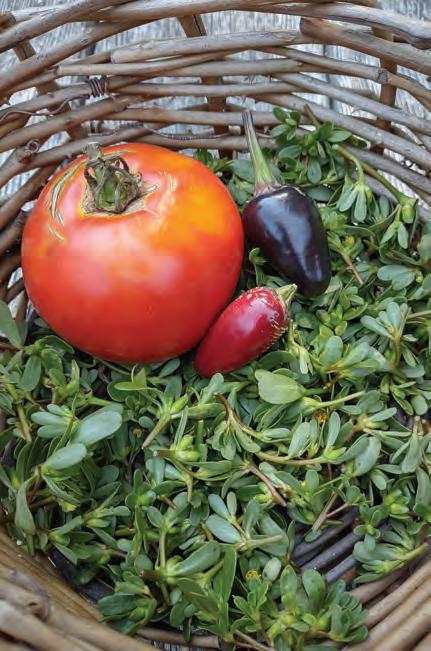
1 or more peppers, minced, sweet or hot as you prefer (I like fully ripe Czech Black peppers, which are mildly hot, but not wicked.)
Toss and serve fresh.
Purslane Stem Quick Pickles
Break the purslane stems into lengths and toss them in a jar of leftover pickle juice, sweet or sour, commercial or homemade, any kind you like. If you have no pickle juice, use half water and half vinegar. Let the stems sit in the pickle juice in the fridge for a day or two for a crunchy lemony pickle-y treat that is terrifically healthy as well as tasty.
picking huckleberries in Maine and Canada, finding sassafras, watercress, and nettle on the Vineyard. The thrill of finding food in the wild never gets old. And Gilbert makes a wonderful case for eating invasives, pointing out plants we can eat that will actually help nature if we consume them.
This book reminded me of that magical mushroom-foraging experience with Julie. It’s not a comprehensive tome. Instead, it can stroll with you in your backpack, and reads like a dear friend, taking you by the hand and saying, “Come over here. I have something really cool to show you.”
“Weedy Wisdom for the Curious Forager: Common Wild Plants to Nourish Your Body and Soul” by Rebecca Randall Gilbert, $16.99, paperback. Available at Bunch of Grapes Bookstore in Vineyard Haven, Edgartown Books, and online.
 Purslane, peppers, and a
Purslane, peppers, and a
harvest 2022 31 Wild things BOOKS
Leaves and stems from purslane weeds are edible.
tomato can be combined for a salad.
Cronig brothers’ public market in New Bedford before it was closed in the 1920s.
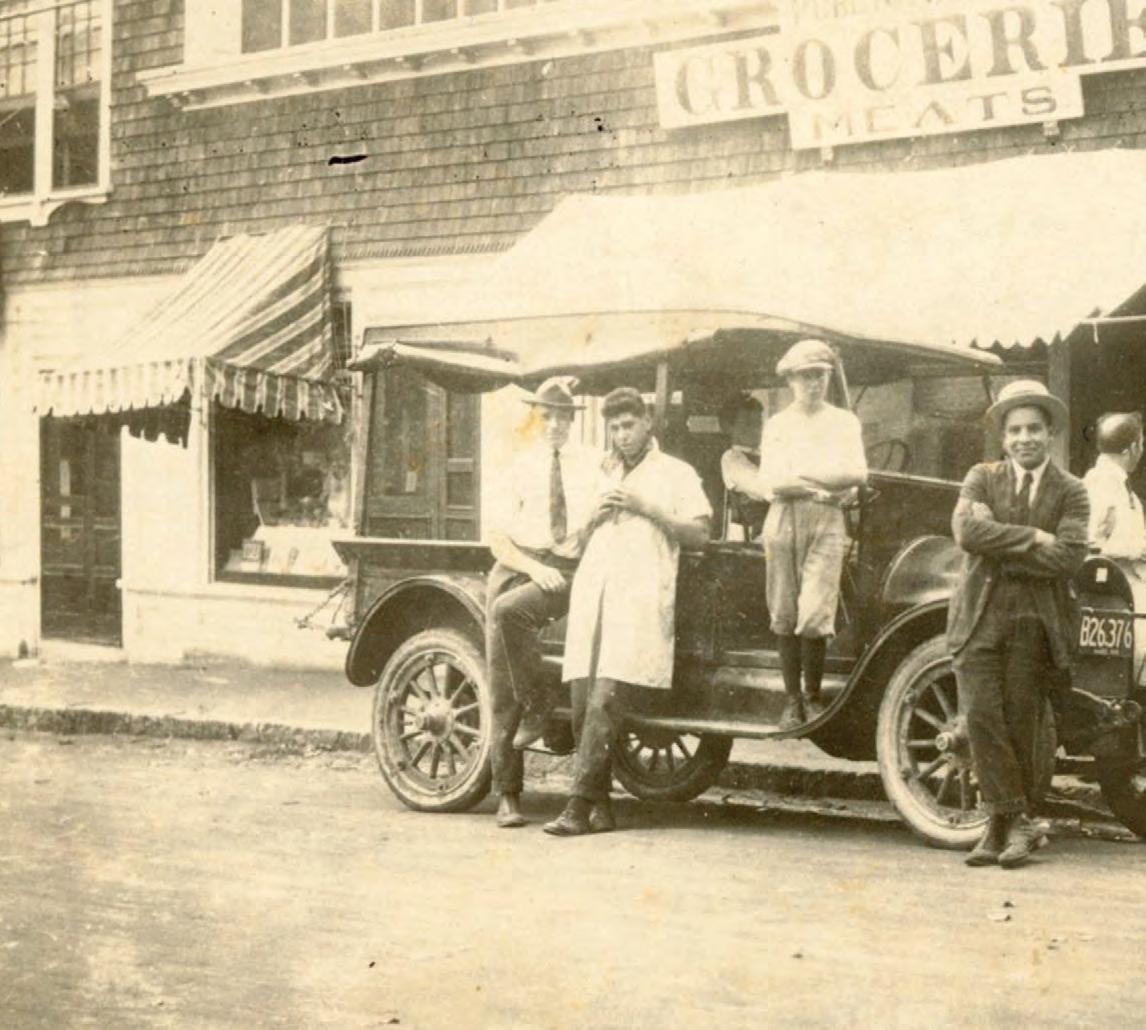
customs Culinary
 WORDS Mollie Doyle
WORDS Mollie Doyle
Museum exhibit explores the beginnings of the Island’s Jewish community, including traditions and celebrations.
Imet Bess Abrahams (daughter of Carole Cronig Abrahams of Vine yard Haven) at the Island The atre Workshop when I was about 8 or 9. Early on in our friendship, Bess and I would use our play rehearsal times to confide in each other. They were benign confessions. Things like: “I know it sounds gross, but I like to eat red grapes with cheddar cheese!” or “I
FEATURE Culinary customs 32 edible VINEYARD
sometimes sleep with a light on in the bathroom.” But then, one day, Bess pulled me aside during a rehearsal for “The Space Be tween” and told me most seriously, “My mom and her sisters are not happy with the Rabbi right now.” While I never learned the details around this particular displeasure with the Rabbi, I did learn, over the ensuing years, that critically evaluating one’s teachers, lead ers — especially spiritual leaders — was, in
essence, part of the Cronig Abrahams’ family tradition, which has always been one of the things I love most about them.
I was recently reminded of all this while visiting the Martha’s Vineyard Museum’s excellent exhibit: “They Planted the Seeds: Creating Jewish Community on Martha’s Vineyard.” In her interview with the museum’s oral historian and co-curator Linsey Lee, Helen Issoksen says, “A Rabbi’s position in a congregation is under such scrutiny. It’s worse than the President of the United States. The President of the United States has nothing on the rabbi of a diverse congregation.”
As co-curator Bonnie Stacy told me, the idea for the museum’s exhibit began as a way to commemorate the Hebrew Cen ter’s 70th anniversary in 2020, but due to COVID it got pushed back. “And then, when the Hebrew Center decided to donate its papers to the museum’s official archive, the breadth of it expanded. There were these incredible photographs and Linsey Lee had these wonderful oral histories that tied in with the papers and we felt we needed to tell a bigger story: the Jewish Immigrant experience here on the Island,” Bonnie said. In 1911, Samuel Cronig came to the Island followed by Judel Brickman in 1913. Then came the Butlers, the Halls, Issoksens, Kliglers, Levinsons, Millers, Osmans, and Pearlsteins. These families, among many others, set up institutions that have defined our community, including how we eat. In the same interview with Linsey Lee, Helen Is soksen says, “I swear we introduced bagels to the Island.”
Co-curator Linsey Lee shares that some of her interviews, such as with Anne Cronig, are from the 1990s. “The thing about this project is that it is so wonderful looking into Jewish community here because you can get right back to the beginning. I didn’t know some of these people, but I certainly
saw them in the store. I also love that this is the story of the formation of a community. There is a kind of bravery in coming to this country, not knowing English, having no money and, within a number of years, earn ing enough to bring one’s brothers over and then establishing something like Cronig’s, which is one of the anchor stores of the Vine yard. It’s a very American experience,” Linsey reflects. “I also appreciate the fact that when there was a minion of ten men in Vineyard Haven, that they started a Hebrew Center rather than a temple, making a place that would attract all sorts of people. Today, it is one of the intellectual hubs of the Vineyard for everybody because it is very ecumenical.”
In their research for the exhibit, co-cu rators Linsey Lee and Bonnie Stacy worked with a group of advisors including Rabbi Broitman, Gayle Stiller, Linda Vadasz, Sally Kohn, Peter Cronig, Edward Kaplan, Elisa Kappell, Claudia Canerdy, Benjamin Hall Sr, Charlotte Hall, Nancy Salon, Jeffery Kram er, Carole Abrahams, and Joan Nathan. Many of these folks loaned photographs and extraordinary objects for the exhibit. A few standouts: Jeffrey Kramer loaned the Cronig’s sign, which reads, “If you are on earth, own a slice of it”; Claudia Canerdy donated a sign-making kit that was used in Edgartown’s Hall’s Department Store; Nancy Salon loaned her son Salon Nunes’ cookbook “Kugels and More” from his bar mitzvah. Joan Nathan brought her expertise on Jewish food. “Joan searched through the museum’s cookbook archives, looking for early Jewish recipes. She found so many recipes. It’s wonderful! So, as part of the exhibition, is giving a talk about what she’s found,” Bonnie said.
Joan Nathan is of course one of the pre-eminent experts on Jewish cooking and food in America. When I call her up to talk to her about her relationship with


Courtesy M.V. Museum
“There is a kind of bravery in coming to this country, not knowing English, having no money, and within a number of years, earning enough to bring one’s brothers over and then establishing something like Cronig’s …”
–Linsey Lee, museum oral historian
harvest 2022 33 Culinary customs FEATURE
FEATURE
customs
2. M.V. Hebrew Center
3. Breakfast at the old Hebrew Center for an Israel bonds drive, 1989.
4. An early sign from the Cronig family.


the Island and research for the museum and her talk, she tells me that she and her late husband, Alan Gerson, first came to Martha’s Vineyard in 1976 when she was pregnant with her daughter Daniela to visit Massachusetts Supreme Court Justice Ben Kaplan and his wife Felicia Lamport. “We just loved it and started renting all these inexpensive mice infested places in Chilmark,” she laughs. Then, when her TV series “Jewish Cooking in America” came out she was invited to come speak at the Hebrew Center. Alan came along and they asked Jim Feiner to take them around to look at properties. They found some land off of North Road and bought it. “It was the smartest thing we ever did,” she says.
Joan shares that beyond spending her summers here, her family will often come up from Washington, D.C.. to celebrate Rosh Hashanah. “We’ll gather here after syna gogue and have a luncheon. I usually make a salmon or striped bass gefilte fish ring, a sweet and sour fish recipe. It’s German. Brisket, which is really hard to get here on the Island. Then I’ll make an Israeli couscous and vegetables and salads from the garden. I usually make my own horseradish and I want to make some this year, but I’ve got to find it in the garden. And then there’s my family’s Italian plum tart. Of course people bring their own contributions and family recipes too. During the shutdown for COVID,
we turned our deck into a synagogue and gathered here for services.”
We talk about the recipes she discovered in the museum archives. “I found a cookbook from 1925 called ‘Vineyard Recipes.’ It was a cookbook the hospital put out. It had all kinds of things in it,” Joan notes, “and all the recipes are identified as being from one place or another. German, English, Russian, Czech, and then there’s a recipe for potato pudding, which has no country designation, but is, of course, Jewish.” Another cookbook she found has a recipe for Jewish Herring Salad by Mrs. Edward Cronig. “And there is a later cookbook featuring a recipe by Ms. Kestenbaum from Oak Bluffs for Russian Noodle Pudding, which is, of course, a ku gel,” she laughs. “It’s amazing.”

I think it is also amazing that Vineyard ers have been cooking for the high holy holidays — Passover, Rosh Hashanah, Yom Kippur, and Hanukkah — for more than 100 years — but learn from an interview with Linsey Lee and the late Anne Cronig that this assumption is wrong. In the interview, Anne Cronig says, “We didn’t have much in the way of religious upbringing, but what little we had, we had in member’s homes… They talk about celebrating Hanukkah. I’d never heard of Hanukkah when I was growing up. But because Christmas comes at that time of year, Hanukkah has become more important on the Jewish calendar as
a sort of consolation prize for the children of the Jewish faith I think… Well, we never celebrated Hanukkah. I’d never even heard of it. It’s a very minor holiday.”
Nonetheless, these days Hanukkah is cel ebrated here. So we thought for our harvest issue, which happens to come out around the High Holidays, that Edible would join the celebrations with some time tested recipes from this century’s Island Jewish cooks. We have aimed for foolproof, anyone-can-makethis-and-it-is-delicious recipes. And, in honor of the fact that there are so many wonder ful cooks on the Island, we have curated a potluck recipe party for you and friends to divvy up and cook with. As Linsey Lee pointed out, “The Jewish community here is a true potluck of what all the people can bring — morally, intellectually, physically.” And I would add gustatorially. Joan Nathan’s challah recipe is unparalleled. I have eaten some braided by her hands. Wow. And it is easy to make as well. As is her beef brisket. My friend Rebekah Thomson’s mom Susan Parker’s latkes are, in my daughter’s words, “Simply the best.” And chef Krem Miskevich of Good Pierogi and Fantzye Bagels shared their Polish recipe for Sufganiyot (jelly filled donuts! YUM!). Krem told me, “I do not have any story behind this recipe, except that I love a moist, squishy donut.” What I love about all of these recipes is that they are in one way or another part of our Vineyard
 1. The “Island Cook Book,” published in 1924 to benefit the M.V. Hospital, contained favorite recipes from Islanders.
4
Photos: 1. Courtesy Chris Baer; 2. Courtesy M.V. Museum; 3. Courtesy M.V. Museum; 4. Tina Miller
1. The “Island Cook Book,” published in 1924 to benefit the M.V. Hospital, contained favorite recipes from Islanders.
4
Photos: 1. Courtesy Chris Baer; 2. Courtesy M.V. Museum; 3. Courtesy M.V. Museum; 4. Tina Miller
34 edible VINEYARD
Culinary
2 3
1
family history. And the simple act of making these foods makes a new history. So chag sameach [pronounced: khag sah–meh-ahkh] or happy holiday!
Joan Nathan’s Favorite Challah Recipe (Also ours!)
Yield: 2 challahs
1½ packages active dry yeast (about 3½ tsp.)
1 Tbsp. plus ½ cup sugar
½ cup vegetable oil, more for greasing bowl
5 large eggs
1 Tbsp. salt
8 to 8½ cups all-purpose flour
In a large bowl, dissolve yeast and 1 Tbsp. sugar in 1¾ cups lukewarm water.
Whisk oil into yeast, then beat in 4 eggs, one at a time, with remaining sugar and salt. Gradually add flour. When dough holds together, it is ready for kneading. (You can also use a mixer with a dough hook for both mixing and kneading.)
Turn dough onto a floured surface and knead until smooth. Clean out the bowl and grease it, then return the dough to the bowl. Cover with plastic wrap and let rise in a
warm place for 1 hour, until almost doubled in size. Dough may also rise in an oven that has been warmed to 150°, then turned off. Punch down dough, cover and let rise again in a warm place for another half-hour.
To make a six-braid challah, either straight or circular, take half the dough and form it into six balls. With your hands, roll each ball into a strand about 12 inches long and 1½ inches wide. Place the six in a row, parallel to one another. Pinch the tops of the strands together. Move the outside right strand over two strands. Then take the sec ond strand from the left, and move it to the far right. Take the outside left strand, and move it over two. Move the second strand from the right over to the far left. Start over with the outside right strand. Continue this until all strands are braided.
For a straight loaf, tuck ends under neath. For a circular loaf, twist into a circle, pinching ends together. Make a second loaf the same way. Place braided loaves on a greased cookie sheet with at least 2 inches in between.
Beat remaining egg and brush it on loaves. Either freeze breads, or let rise another hour.
If baking immediately, preheat the oven to 375° and brush loaves again. If freezing, remove from the freezer five hours before baking. Dip your index finger in the egg wash, then into poppy or sesame seeds, and then onto a mound of bread. Continue until bread is decorated with seeds.
Bake in the middle of the oven for 35 to 40 minutes, or until golden. Cool loaves on a rack.
Joan Nathan’s Brisket in Sweet-and-Sour Sauce (Serves 12)
In the New York Times, Joan wrote, “Brisket is the Zelig of the kitchen. It takes on the character of whoever cooks it. In the early
part of the 20th century, when ‘The Settle ment Cook Book’ reigned supreme in Amer ican Jewish households, recipes for savory briskets of beef with sauerkraut, cabbage, or lima beans were the norm. As tastes became more exotic, cranberry or barbecue sauce, root beer, lemonade and even sake worked their way into recipes. Here, Coca-Cola is the secret ingredient, along with ginger. The result is sublime, and the dish only improves if it’s cooked a day in advance of serving it. However, you can prepare and serve it the same day if you’d like, though you may want to use a fat separator to strain the fat from the finished sauce. Several readers commented that the original cooking time and temperature on the recipe (three hours, including one hour uncovered, at 350°) were inaccurate. We’ve retested and adjusted the recipe, so the brisket now cooks for five to six hours, covered, at 325°. Please also note that this recipe is not kosher for Passover.”
1 medium onion, peeled and quartered
12-in piece fresh ginger, peeled, cut into chunks
6 large cloves garlic
1 cup ketchup
½ cup dry red wine
¼ cup cider vinegar
¼ cup soy sauce
¼ cup honey
¼ cup Dijon mustard

1 Tbsp. coarsely ground pepper, or to taste
¼ tsp. ground cloves
1½ cups Coca-Cola or ginger ale
½ cup olive oil
1 first-cut brisket, 6 to 7 pounds, rinsed and patted thoroughly dry
Gabriela Herman
“There is a later cookbook featuring a recipe by Ms. Kestenbaum from Oak Bluffs for Russian Noodle Pudding, which is of course a kugel.”
–Joan Nathan, cookbook author and journalist
Joan Nathan
harvest 2022 35 Culinary customs FEATURE
Continued on page 46
As summer fades and autumn finally begins to cool things off, many bourbon and rye enthu siasts start the countdown to the fall releases.
The Pappy Van Winkles, William Larue Weller, Eagle Rare 17, Thomas H. Handy Sazerac and the rest, all represent the chance to pay top dollar for libations that can be had at a fraction of the price. While it’s nice to snag one of these rare bottles, you can get just as much pleasure with these familiar labels.
For bourbons
Our favorites have different textures and flavors determined by longstanding house recipes, but all have one constant — 51 percent corn in the blend — which, combined with “barrel char,” time in the barrel imparts the sweet flavors and savory aromas.
Time for bourbon and rye
WORDS Jamie McNeely
Elijah Craig Small Batch Bourbon
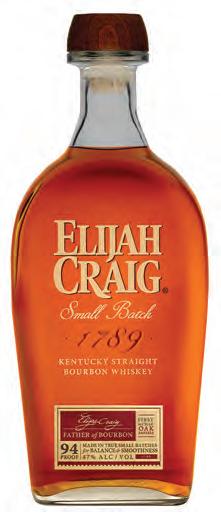
Subtle smoke, warm spice flavor and nice length on finish.
Angel’s Envy Bourbon

Finished in port wine barrels for six months. Hints of vanilla and spicy chocolate.
Woodford Double cask Bourbon

Finished in a second oak barrel with heavy char imparting sweet oak, dark caramel and hazelnut.
For rye
Same long-standing house recipes and barrel char, except 51 percent rye in the blend.
Sazerac Rye

Aged 6 years. Peppermint spice, honey, and cinnamon.
High West Double Rye

A blend of two rye whiskeys from two different distilleries, each aged a minimum of two years. Woody caramel spice, eucalyptus, and cinnamon.
Whistle Pig 10-year Rye
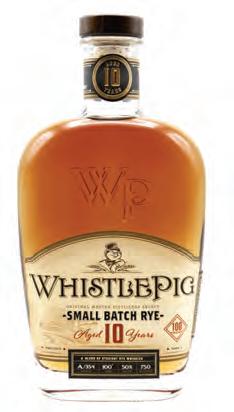
Big powerful spice bomb with caramel, cinnamon and a long satisfying finish.
Jamie McNeely is president and general manager at Our Market and Vineyard Wine Shop in Oak Bluffs and Your Market in Edgartown.
36 edible VINEYARD
DRINKS

® certi edhumane.org
Everett checking the progress.
After a full night of smoking, the pig is perfectly done.
SMOKIN’ THE HOG
Pig roasts are an Island harvest tradition, passed down from generation to generation.

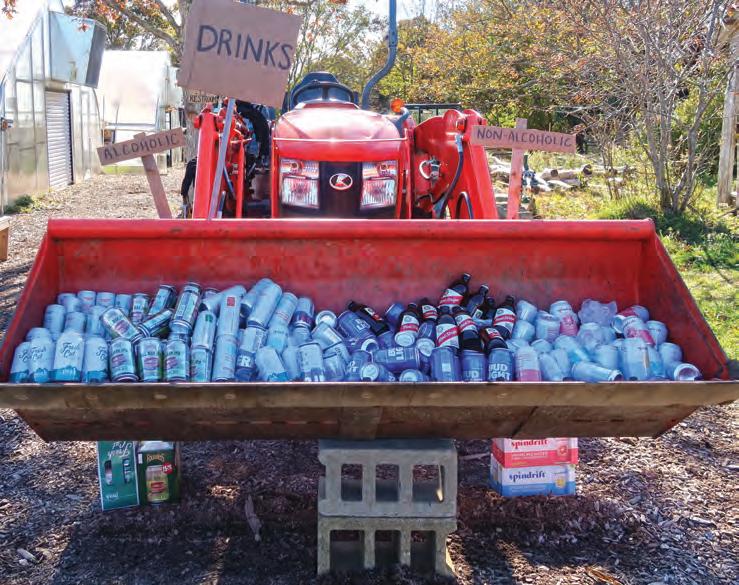
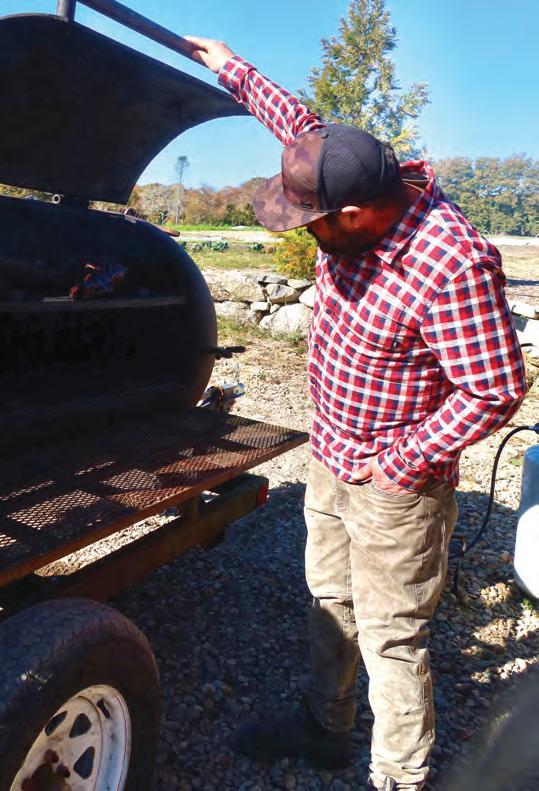
Cutting into the whole pig.
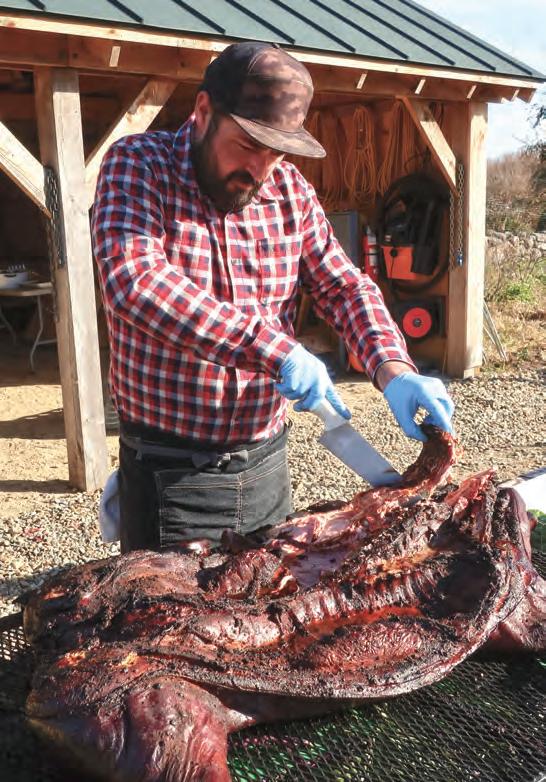 WORDS AND IMAGES Tina Miller
Cold drinks in a unique cooler.
WORDS AND IMAGES Tina Miller
Cold drinks in a unique cooler.
38 edible VINEYARD
harvest 2022 38
FARM AND SEA
Aafter a long, busy summer on the Island, fall sets in on the Vineyard, and the community is ready to gather with friends and family to take a collective breath. Back in the day on the Island, there were some unique events to celebrate fall, such as the Columbus Day Crunch in Aquinnah, and the Thanksgiving Day weekend horse race in West Tisbury. As a kid, I remember these events being quite wild, with plenty of grownups partying with gusto.
As times changed, common sense and safety prevailed, and fall events like those faded. But one farm tradition continues — definitely a lot safer than a car derby and a horse race: the fall pig roast.
As a kid, I remember going to an annual pig roast in West Tisbury, with homemade applesauce, and after a full night of cooking over hot coals, a giant hog was placed on a wooden table and people gathered around filling their plates with tasty, juicy, tender pork. There were also endless potluck dishes strewed about, and always lots of adult
beverages. I will never forget how flavorful the pork tasted, something that can be lost in big-factory-farmed pork.
Everett Whiting is the chef and co-owner of the Fish House at the Airport Business Park. Everett grew up raising animals for food on the family’s iconic West Tisbury
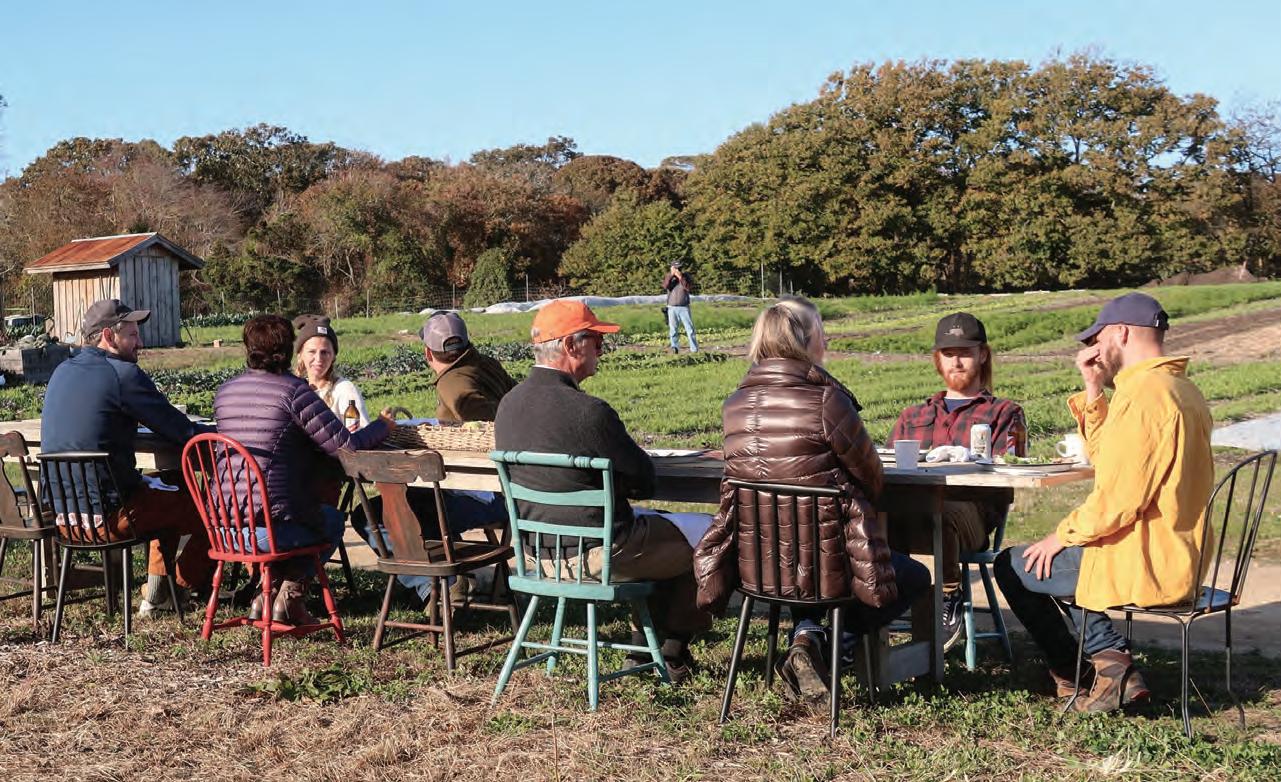
farm, aptly named Whiting’s Farm. He remembers his uncle, Danny Whiting, was always in charge of the pig roasts when he was young.
“It’s a fall thing for anyone that grows food,” Everett says. “When the weather gets cool, end of the season around November, the pig roast is your harvest reward. Pig roasts are a generational tradition.”
Like anything with value, good things come to those who wait, but for those roasting a whole pig, it is a lot more.
“Doing a pig roast, you get to see the whole night and the morning, it’s a lot of work. I’ve seen some debaucheries,” laughs Everett. “You really need to keep your eye on the process.”
Cultures around the world have been roasting whole pigs over a fire for generations, using a spit over the hot coals or sometimes a metal, two-sided-type cage that encases the pig so that it can be flipped over to cook evenly.
“When the weather gets cool, end of the season around November, the pig roast is your harvest reward. Pig roasts are a generational tradition.”
–Everett Whiting
Smokin’ the hog FARM AND SEA
Friends and family gathered for the fall feast.
harvest 2022 39
Though he grew up seeing spit-style pig roasts, Everett changed things up when he started, using an indirect barrel wood smoker.

“I started using a smoker when I wanted more control, especially over the weather. An open spit or fire is less reliable, less consistent,” he says.
Also, if you are doing an open fire, you need to pick the right location. With a smoker on a trailer, location and weather become less of an issue. You can do multiple pigs, up to four whole pigs, or 24 chickens at a time.
Everett says depending on the size, it takes about 12 to 14 hours to smoke a whole pig.
The finished pork should be between 210° and 220°, with the temperature
taken at the pig’s leg,
For about eight years, Everett raised his own pigs, and created undeniably one of the favorite food venues at the Martha’s Vineyard Ag Fair — slow-smoked sandwiches served with local vegetable sides. Everett and a crew would smoke up to 24 pigs over the four-day fair.
Raising his own pigs on the farm for the fair was an all-consuming commitment. The size of the pigs would vary, but usually they would end up in the 100-pound range, with runts running around 50 pounds and larger pigs up to 130 pounds.
Before smoking, Everett covers the pig with a dry rub, Texas-style. Spices like paprika, garlic powder, salt, pepper, and some other secret spices are used.
“There are so many variables, so I keep it simple,” Everett explains. Depending on the size of the pig, it is a slow and patient process to roast a pig. “I like cooking with fire in general,” he says. “For me, it’s about the wood — clear, white oak is my preference. My style is a bit different; I cook it a bit hotter, so it doesn’t taste only of smoke.”
With Everett’s work at the Fish House, pig roasts are back to being an end-of-the-season celebration rather than a full-time job.
“I love cooking the Island’s bounty,” Everett says with a smile. “We live in a community rewarded by so many great farms and people that know and appreciate locally grown food.”
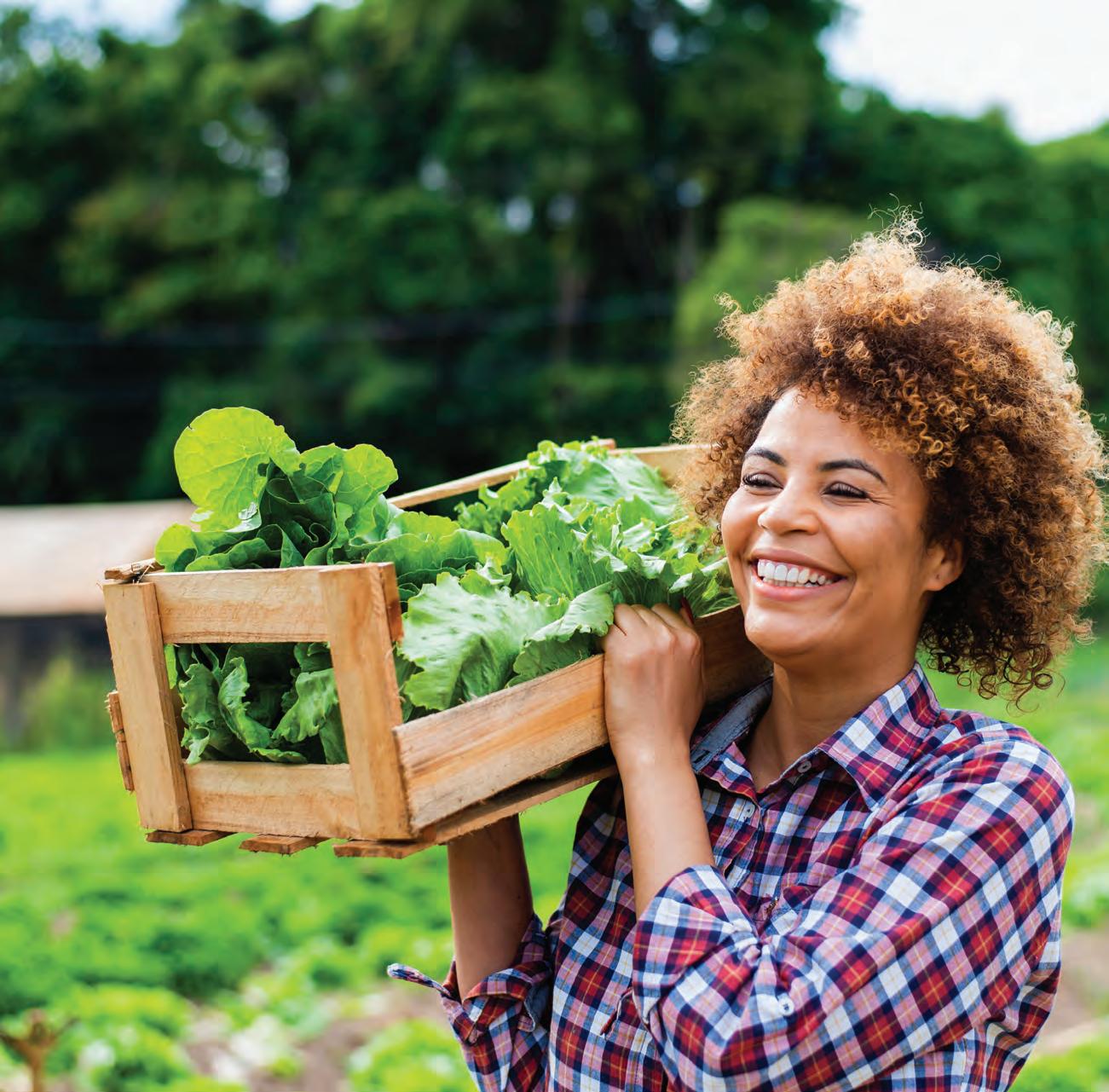 The perfect fall harvest plate.
The perfect fall harvest plate.
40 edible VINEYARD
FARM AND SEA Smokin’ the hog
Get fresh updates on our work to ensure the future of agriculture includes all Americans.
farmland.org
Discrimination against marginalized groups in agriculture negatively affects all Americans by limiting the opportunities for farmers, workers, and consumers.
AFT is raising up diverse voices in agriculture, because we believe diversity contributes to a more resilient agricultural system, a stronger economy, and a more equitable society.

At American Farmland Trust, we believe agriculture is strengthened through diversity, just like the soil.
SUNDAY ROASTED CHICKEN WITH VEGETABLES
 WORDS AND IMAGES Tina Miller
The finished product rests before carving.
WORDS AND IMAGES Tina Miller
The finished product rests before carving.
42 edible VINEYARD IN SEASON Harvest
One of the gifts of living in a place with four distinct seasons is the transitions — transitions in wardrobe, daily routines, food, and cooking. Though I enjoy four seasons and food options, I feel deep nostalgia for fall, and settling into a quieter routine and spending more time cooking at home. The food and how you will cook this time of year shifts as well, perhaps turning your oven on for the first time in a while.
Hearty, colorful veggies, perfect for roasting, are bountiful. And at our house, it is back to Sunday Chicken. I know many of us claim to have the best roasted chicken … But I do make the best roasted chicken! Of course, any best is all relative, but the guys in my family love this roasted chicken.
As with anything, cooking evolves over time, but I have settled on this method for a while now, with the exception of one big change. Two years ago I bought a countertop Breville oven. My 17-year-old commercial-grade oven seemed less efficient and inconsistent, with an unfixable broken spring on its door that has to have a shim to keep it closed. It seemed wasteful and time-consuming to preheat the huge oven just for one thing. The Breville is quick to preheat, tight, and very consistent, and many settings include roasting.
My roasted chicken is almost always a one-pot meal — chicken and veggies shar
ing a tight space, with all the wonderful flavors merging and caramelizing.
One other discovery I’ve made over the years: I like a ground spice coating, rather than fresh herbs, for a nice, crispy, flavorful skin.
Sunday Roasted Chicken with Vegetables (Serves 4-plus)
2 Tbsp. olive oil
4- to 5-lb. good-quality chicken
½ lemon
2 Tbsp. ground spice mix
1 medium yellow onion, quartered
Vegetables
Options can include potatoes, carrots, winter squash such as delicata, butternut, acorn, etc. Other choices to try: large Brus sels sprouts, beets, parsnips, or turnips.
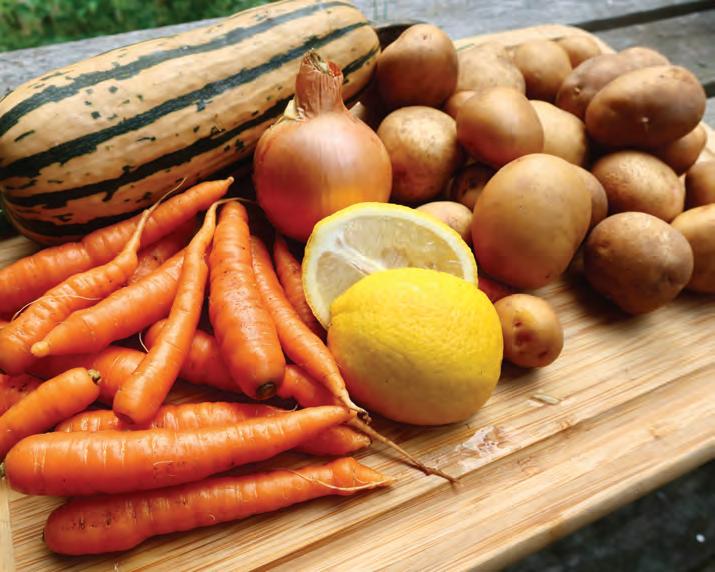
The vegetables should be halved or quartered, and uniform in size so they roast evenly.

Lightly coat veggies in olive oil, and season with salt and pepper.
This is more of a method than a recipe. Preheat the oven to 400°.
To rinse or not rinse your chicken? I always rinse my chicken; the cavity al ways seems to need it. Take note: Be sure your sink area is clean, with no dishes. You do not want to cross-contaminate raw meat, especially chicken. I carefully dry my chicken — you want the skin espe cially dry for the next step. (I use bleach spray on the sink when I am done.)
Use a shallow, heavy baking pan for this dish. I have a copper oval that fits perfectly in the oven, but a cast iron fits as well. Add olive oil evenly around the bottom of the baking pan. Breast-side down, generously coat the chicken. When coated, turn the breast side up. Add half a lemon to the cavity. Season the chicken with salt and pepper and the dry ground spice mix evenly over the whole top of the chicken. (I use a mixture of Trader Joe's Mushroom Umami seasoning blend, Old Bay, and whatever else is around, but finely ground.)
Roast chicken for 1 hour. Remove and baste the chicken. Add vegetables around the chicken, tucking them in so the pan is full. Return to the oven, and bake for another 30 minutes. Remove chicken again, baste well, and cover the chicken only with foil, to protect the skin. Bake for another 30 minutes. Remove from the oven, baste again, add the foil as a tent, and let rest for at least 10 minutes before carving.
Island vegetables are ready to be chopped for roasting.
Island vegetables are ready for roasting.
harvest 2022 43 Sunday Roasted Chicken IN SEASON
Katama Farm in 2008, years before she started Slough Farm. “There were only three cows there that were producing, that we would breed,” she says. “We slowly built the herd there, and learned a lot from it. All cows are not created equal — you can’t have a cow that’s been raised in confinement or on a lot of grain, and expect them to just be able to graze, and the same is true for the bull. Genetically, there are certain animals and breeds that are able to thrive on grass. You hear a lot about heritage breeds — they’re the heirloom vegetables of the animal world.” Heritage breeds haven’t been bred to thrive in the feedlot environment, and they’re better suited to outdoor living.

“Katama is windy, open, close to the water, and it’s cold in winter,” Julie says. “We find the Scottish breeds — the Scottish Highland, Galloways, and Devons — thrive in the winter, and are more efficient on feed.”
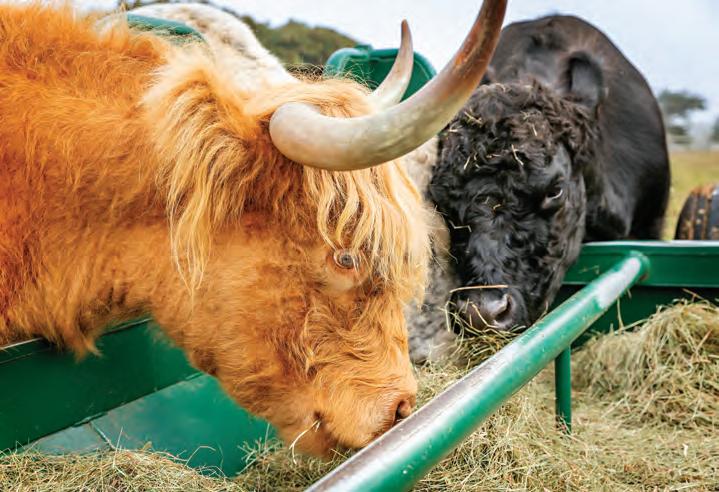
The shaggy brown Scottish Highland cows are less challenged by the cold than many breeds. Then again, when it comes to summer, the hardy cows need shade to keep cool, which is in short supply in Katama. Julie didn’t commit to the Scottish Highland cows until she had gotten shade structures to move around the pastures with the cows. When it came time to get a
Morning hay at Slough Farm.
new bull, though, she decided on another breed, a British White Park. She says that it’s not considered a pure heritage breed, but is somewhere in between the older breeds and modern production animals.
Archie the White Park bull has already visited Nip ’N’ Tuck, Morning Glory, and Blackwater Farms. For Morning Glory Farm, Dan was breeding white-faced Her
efords, then he got a Red Devon bull, Mosh up, and is now sharing Archie with Slough Farm. This leaves him with a herd that’s a Devon and White Park cross, with a bit of Hereford. The cows gain hybrid vigor from the diversity in their genetic backgrounds, and the system works because not all of the farms breed at the same time of year.
“People calve at different times of the
“We find the Scottish breeds — the Scottish Highland, Galloways, and Devons — thrive in the winter, and are more efficient on feed.” –Julie Scott, Slough Farm
Continued from page 13 FEATURE Cattle calling 44 edible VINEYARD
year,” Julie says. “We prefer fall calving, but some do spring. It depends on your market and your staffing.”

The Slough Farm animals are ready for processing in the fall, but the meat isn’t available for sale anywhere. Instead, it’s distributed through the Island Grown Initiative’s food equity program. The meat goes to the Food Pantry, the community
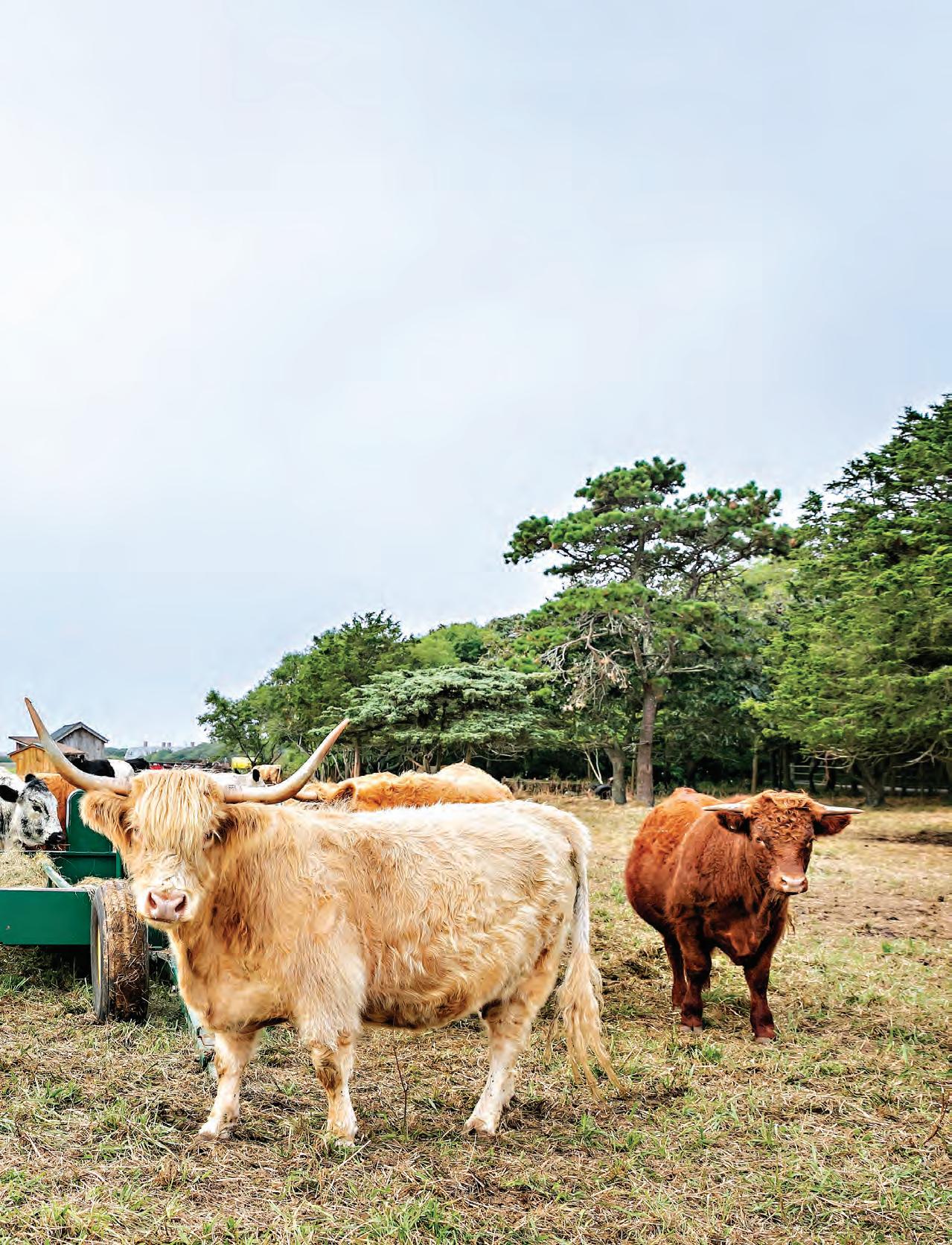
lunch program, and school cafeterias: “We donate everything we produce. We have founders who fund the operation strictly to benefit the Island. We’re producing the best of the best, and nobody can buy it. We work with the school cooks to figure out what cuts they want, and we want to produce enough to make an impact.” For those who want to buy locally produced beef, there are plenty of other options. (See sidebar.)
“I do think we’re lucky on Martha’s Vineyard,” Julie says. “There are a lot of
Where’s the beef?
Local beef is available from the following farms, some of which may have limited supplies.
Blackwater Farm
40 Cottle Lane, West Tisbury 774-563-0959
Flat Point Farm (limited supplies)
126 Road to Great Neck, West Tisbury 508-693-4343
people that are raising cows, and they’re all being raised in a humane way, even if our practices are different.” Julie manages the barn at the M.V. Agricultural Society’s Agricultural Fair, and says that this year there were more stalls for cows than for any other animal. The amount of beef raised locally is quite small — most grass-fed beef in U.S. markets comes from Australia and South America — but it helps move the Island toward greater food security and more climate-friendly farming practices.
Grey Barn and Farm
thegreybarnandfarm.com
22 South Road, Chilmark 508-645-4854
Mermaid Farm & Dairy
9 Middle Road, Chilmark 508-939-0140
Morning Glory Farm morninggloryfarm.com
290 West Tisbury Road, Edgartown 508-627-9003
Nip ’n’ Tuck at Ghost Island Farm ghostislandfarm.square.site
27 Davis Look Road, West Tisbury 508-693-5161
Julie Scott with her Slough Farm herd.
Beautiful bountiful fur, perfect for the windy climate in Katama.
Cattle calling FEATURE harvest 2022 45
Let meat stand at room temperature for 30 minutes before cooking. Preheat oven to 325°.
Place everything but the soda, olive oil, and brisket into a food processor, and process with steel blade until smooth. Pour the mixture into a large bowl, and whisk in soda and olive oil.
Place brisket, fat side up, into a heavy baking pan just large enough to hold it, and pour sauce over it. Cover tightly and bake for three hours. Turn brisket over, cover pan, and bake two to three hours more, or until fork-tender. Cool, cover brisket, and refrigerate overnight in cooking pan.
The next day, transfer brisket to a cutting board, cut off fat, and slice with a sharp knife against grain to desired thickness. Set meat aside. Remove any congealed fat from sauce, and bring to a boil on top of stove.
Heat oven to 350°. Taste sauce to see if it needs reducing. If so, boil it down for a few minutes, or as needed. Return meat to sauce, and warm in oven for 20 minutes. Serve warm.
Parker Family Potato Latkes
10 large potatoes
(I usually use russet, but also works well with white and/ or red), grated (using larger, round holes in box grater) — I don’t peel them.
2 medium onions, peeled and grated (also using large, round holes in box grater)
2 large eggs, beaten ¼ cup flour or matzo meal vegetable oil
Working in batches, wrap the grated potatoes and onion in a kitchen towel, and squeeze the liquid from them. Combine the potato-onion mixture with the beaten eggs, salt, pepper, and flour.
Over high heat, fill frying pan with ¼ inch oil. Once oil is really hot, carefully place a small handful/large spoonful of mixture into the really hot oil. The mixture should be flattened, but not overly handled. Fry over high heat until golden brown and crispy, then gently flip and brown the other
side. Dry on paper towels.
Serve with applesauce/cinnamon mixture, and/or sour cream.
Krem Miskevich’s Good Pierogi Sufganiyot (Paczki)
(Serves about 15)


4 cups all-purpose flour or
3 cups all-purpose flour and 1 cup cake flour
1 cup warm milk or water
4 egg yolks, medium size 1/3 cup sugar
2 Tbsp. fresh or 1 ½ tsp. active dry yeast cup butter, melted or sunflower oil
2 Tbsp. of vodka — can be omitted nice pinch of salt
Oil (or duck fat) for frying 2.5 -inch ring cutter nice pinch of salt
Measure out all the ingredients first. Make a starter with the yeast, 3 Tbsp. of the warm milk or water, 1 Tbsp. of the flour and 1 Tbsp. of the sugar. Make sure the yeast has dissolved completely, cover the mixture with a cloth and put away in a warm place for 15 minutes or until frothy. The starter should grow and have foam. You could turn your oven on the lowest set
ting/pilot (so the temperature is not more than 95F°), if you’re spending Hanukkah in the cold sides of the world.
Grab a big mixing bowl, place the rest of the flour, sugar, salt and the melted, chilled for a second, butter. You may think that 1/3 cup of sugar is not enough, but it is. The donuts will brown slow enough for the frying time, and you’ll be adding icing and/or jam inside. They will be sweet.
Add the rest of the warm milk or water, the starter and vodka. Why vodka? Because it prevents the dough from absorbing too much fat while frying. If you don’t want alcohol in your recipe, or you don’t have it — no wor ries. First of all, it’s Hanukkah so you want all the fats, second of all if you fry the donuts well, they will only absorb what they need.
Mix the ingredients until combined. You can place it in your standing mixer and knead for 5 minutes or do it by hand for 10. The dough should be wet, sticky, and still pretty loose. Leave it in the same bowl, cover with a cloth and leave to rise. Again, if you’re in true winter, put the dough in a 95° oven. Come back in about 80 minutes.
I don’t like to fill my donuts before frying. I find it to be too messy. Take your favorite jam and put it in a squeeze bottle or a pastry bag with a round tip. If you like icing, mix 4 tsp. of lemon juice and ½ cup of powdered sugar.
The dough should be puffy, fluffy. Dou bled in size. Transfer it onto your work table and roll into a 1-inch thick rectangle. Now use the ring cutter to portion your dough. Try rolling the dough scraps together and cut out a couple more sufganiyot. And don’t use a lot of flour while rolling and portioning, we want the dough as moist as possible.
Let the prepared donuts rise for another 30 minutes underneath that kitchen cloth.
Prepare your table top fryer or a tall pot with oil and heat it to 350F°. You’ll also need a landing strip for the fried donuts, a sheet pan lined with paper towels.
When the donuts have risen, and your oil has heated, start frying the sufganiyot; 2 minutes on each side. I find it to be the easiest to flip them with chopsticks, but a swift pat with a perforated spoon will do it, too. After the donuts are browned nicely, take them out on to the paper to dry from excess oil.
And last, but not least: When the donuts are cool enough (but not cold!) for you to touch them, you can fill them with that jam you put in a pastry bag. Confidently poke the donut with the round tip and squeeze until it oozes. Then, either turn upside down and dunk into your icing bowl or sprinkle with powdered sugar.
Anne Cronig
LINSEY LEE
46 edible VINEYARD
Continued from page 35
COURTESY
FEATURE Culinary customs
We’ve got the

Vineyard covered...
Minute by Minute
Subscribe to the MV Times for just $45 per year. That gets you online access and our daily email newsletter produced by The Times. The Minute will arrive in your mail inbox every weekday around 4 pm, with a roundup of the day’s news, photos, events, specials, and everything MV!



Scanthis QRcode to subscribe now!


high summer 2022 47
By subscribing to The Times, you’ll support local journalism and your favorite Island. Go to mvtimes.com/faqs for more information.
DONE!
Martha’s Vineyard Mycological will move its incredible shiitake mushroom business to bigger pastures in Dutchess County, N.Y., this fall, where it can reach a broader audience and continue to grow.

Truman French and Tucker Pforzheimer met in college, where they took a fungi class and dreamed big — as in big shiitake mushrooms. MVM started in 2015, and now we can watch them grow from afar. Somehow I think this is not the last we will see of those delicious, meaty, nutrient-filled shiitakes.
We’re sure leaving the Vineyard is bittersweet. How has starting a mushroom business from scratch prepared you to bring your company to a bigger, more diverse market?
Tucker Pforzheimer: In farming, as in much else, geography is destiny. By moving to the mainland, we seek to further ours and evolve MVM to better serve its mission: more mushrooms for more people. Land, logs, and streamlined logistics await, but we leave behind (for now) a treasured community that believed in our strange dream from the get-go, and entrusted to us a piece of its diet for seven summers. Thank you to the chefs, cooks, and grocers for lending credence to our conviction that loggrown shiitake belonged on your plates and shelves. Thank you to Julie, Pat, Mark, Patty, and Mark, Claudia, and Lew for inviting MVM into your backyards, spare rooms, and shed fridges. Thank you to Wise Owl Farm for taking us under your wing and accepting the mud that came with it. Thank you to the West Tisbury Farmers Market for preserving the viability of small businesses in their most vulnerable phase. Thanks to all of you who reached for our product again and again since 2015, told your friends, and chose MVM over or alongside the cornucopia of local produce with which we are blessed on Martha’s Vineyard. And, lest I leave with the impression that produce arrives like manna from heaven, thank you to Jack, Ross, and Truman for stimulating the production of around 20 TONS of mushrooms. We’ll be sending more back from the other side of the Sound in 2024, with love for the place that granted us a second act.
An
48 edible VINEYARD DONE !
exit interview with Tucker Pforzheimer of Martha’s Vineyard Mycological MV Times



Vineyard Haven 508-693-4457 • West Tisbury 508-693-2234 Vineyard Haven 508-693-7097



